Shows
 Michele Moore's PodcastSPA111:Definte and Indefinite ArticlesDEFINITE ARTICLES
In English, the definite article, the, is used before a noun to identify a specific person, place, animal, thing or idea. The Spanish Definite Article has to agree in gender and number with the noun it modifies.
the
Singular Plural
Masculine Masculine
el los
Singular Plural
Feminine Feminine
la las
Contractions: al and del
The preposition a, meaning to, at when added to ‘el’ is written as al
The preposition de, meaning of, from when added to ‘el’ is written as del
INDEFINITE ARTICLES
In English, the indefinite articles, a, an, some, are used before a noun to ident...2013-01-1606 min
Michele Moore's PodcastSPA111:Definte and Indefinite ArticlesDEFINITE ARTICLES
In English, the definite article, the, is used before a noun to identify a specific person, place, animal, thing or idea. The Spanish Definite Article has to agree in gender and number with the noun it modifies.
the
Singular Plural
Masculine Masculine
el los
Singular Plural
Feminine Feminine
la las
Contractions: al and del
The preposition a, meaning to, at when added to ‘el’ is written as al
The preposition de, meaning of, from when added to ‘el’ is written as del
INDEFINITE ARTICLES
In English, the indefinite articles, a, an, some, are used before a noun to ident...2013-01-1606 min Michele Moore's PodcastSPA112 Survival Spanish day 2Review of SPA1112013-01-101h 02
Michele Moore's PodcastSPA112 Survival Spanish day 2Review of SPA1112013-01-101h 02 Michele Moore's PodcastSPA112: Hace que ...Hace que..., Hace...meaning ago
1. To express how long something has been going on, in Spanish we use the following expression:
HACE + length of time + QUE + verb in the present tense
Hace dos años que vivo aquí. I have been living here for 2 years.
Hace dos días que Sally no viene a clase. Sally hasn't come to class for 2 days. (It has been 2 days since she has come to class.)
2. If you want to ask how long something has been going on, you use the following:
¿Cuánto tiempo hace que + verb in the present tense?
¿Cuánto tie...2012-10-2520 min
Michele Moore's PodcastSPA112: Hace que ...Hace que..., Hace...meaning ago
1. To express how long something has been going on, in Spanish we use the following expression:
HACE + length of time + QUE + verb in the present tense
Hace dos años que vivo aquí. I have been living here for 2 years.
Hace dos días que Sally no viene a clase. Sally hasn't come to class for 2 days. (It has been 2 days since she has come to class.)
2. If you want to ask how long something has been going on, you use the following:
¿Cuánto tiempo hace que + verb in the present tense?
¿Cuánto tie...2012-10-2520 min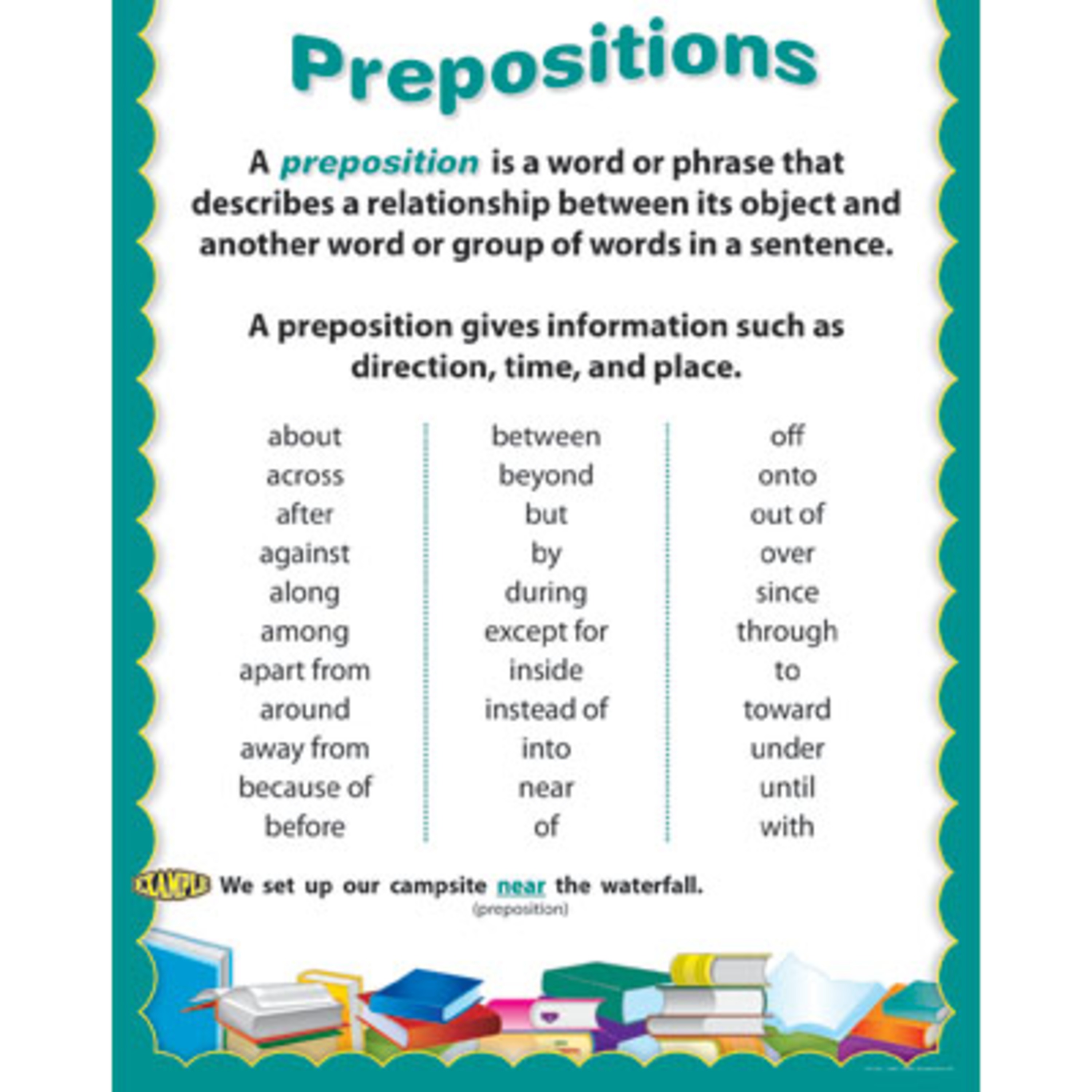 Michele Moore's PodcastSPI214 Intro to Translations: PrepositionsNotes will be posted soon2012-10-2529 min
Michele Moore's PodcastSPI214 Intro to Translations: PrepositionsNotes will be posted soon2012-10-2529 min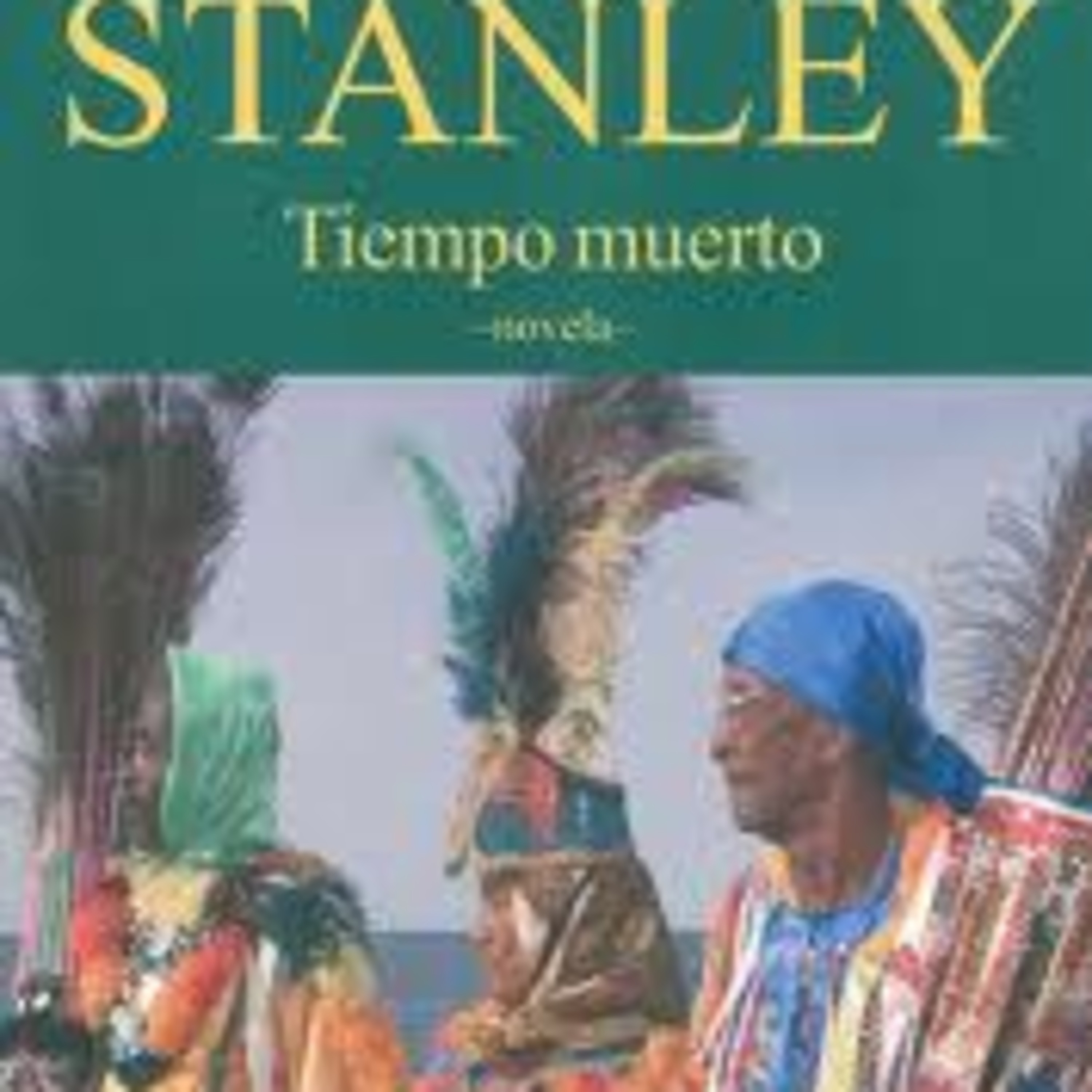 Michele Moore's PodcastSPA211: Tiempo Muerto page 2this is page 22012-09-2305 min
Michele Moore's PodcastSPA211: Tiempo Muerto page 2this is page 22012-09-2305 min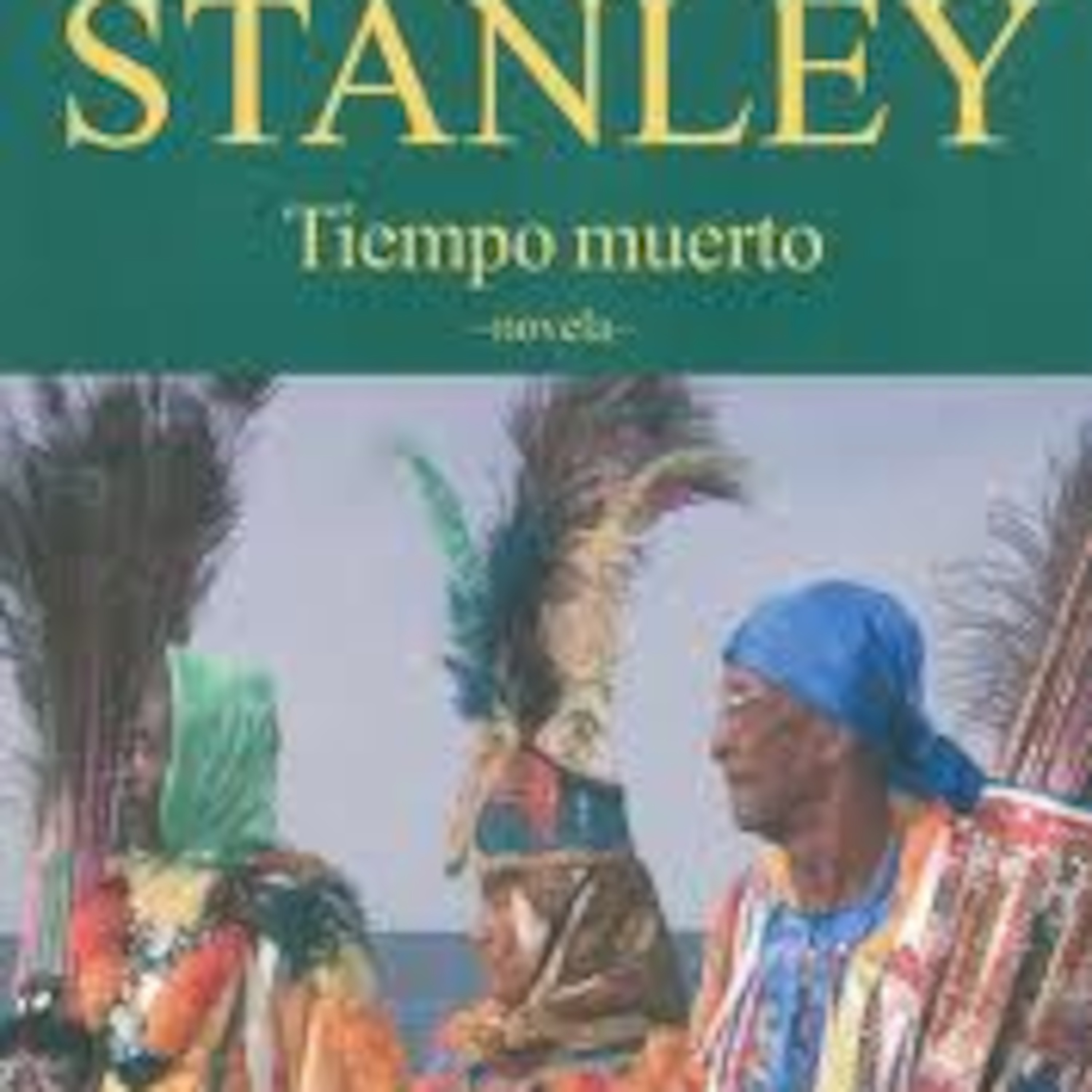 Michele Moore's PodcastSPA211: Tiempo Muerto page 1Here is audio of page 1. I hope this works.2012-09-2302 min
Michele Moore's PodcastSPA211: Tiempo Muerto page 1Here is audio of page 1. I hope this works.2012-09-2302 min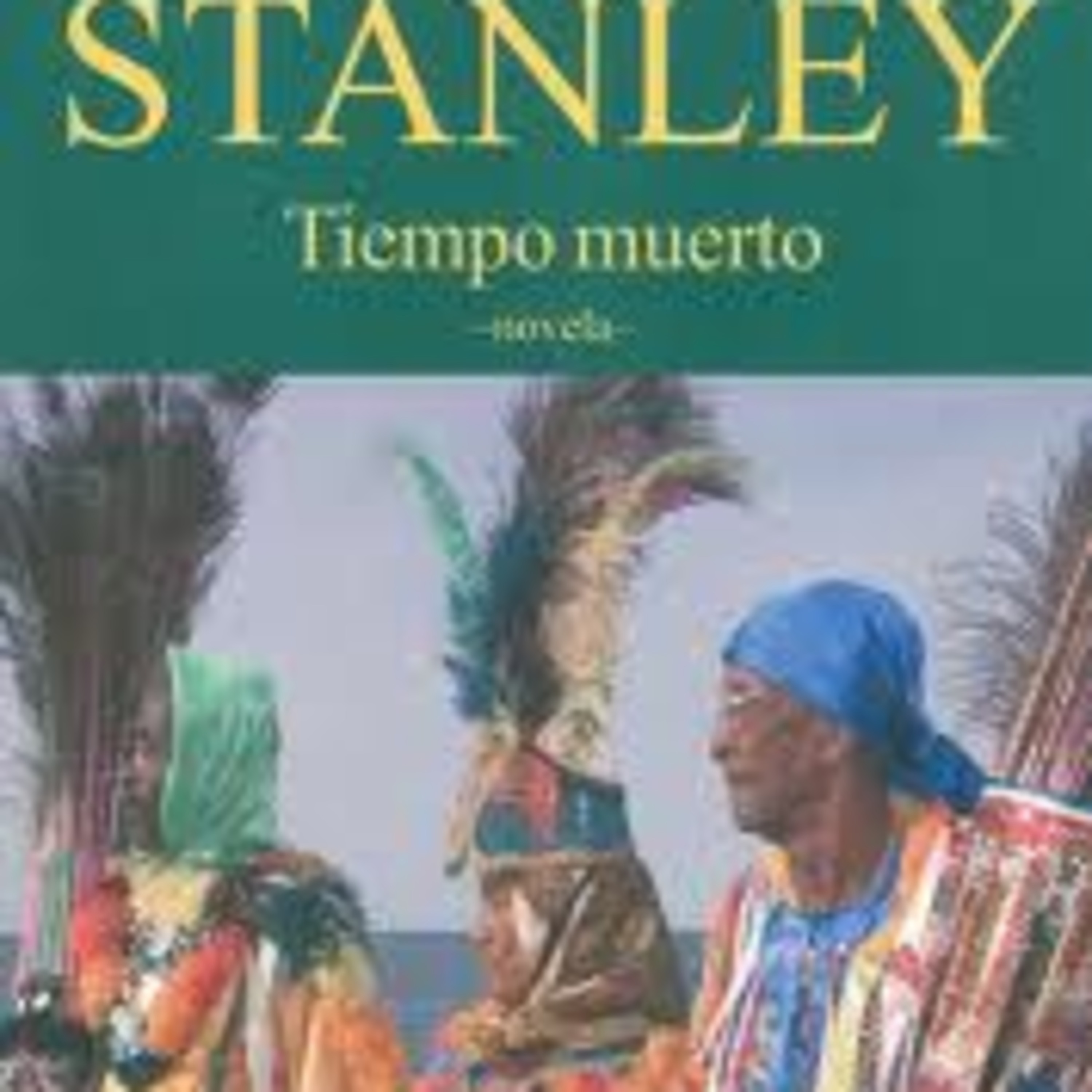 Michele Moore's PodcastSPA211: Tiempo Muerto page 3Here are the audio clips... Hope this works.2012-09-2304 min
Michele Moore's PodcastSPA211: Tiempo Muerto page 3Here are the audio clips... Hope this works.2012-09-2304 min Michele Moore's PodcastSPA111 Fall 2012 AdjectivesADJECTIVES:
POSITION of DESCRIPTIVE ADJECTIVES; AGREEMENT of NUMBER and GENDER
An adjective is a word that describes a noun or pronoun, while there are different kinds of adjectives; this section focuses only on DESCRIPTIVE ADJECTIVES.
In English, a descriptive adjective does not change.
The red school, the red car, the red shirts, the red birds
All of things, no matter how different they are, are all big.
In Spanish, the descriptive adjective must agree in number and in gender with the noun it modifies.
Feminine singular la escuela roja
Masculine singular el auto rojo
Feminine plural las camisas rojas
...2012-09-1007 min
Michele Moore's PodcastSPA111 Fall 2012 AdjectivesADJECTIVES:
POSITION of DESCRIPTIVE ADJECTIVES; AGREEMENT of NUMBER and GENDER
An adjective is a word that describes a noun or pronoun, while there are different kinds of adjectives; this section focuses only on DESCRIPTIVE ADJECTIVES.
In English, a descriptive adjective does not change.
The red school, the red car, the red shirts, the red birds
All of things, no matter how different they are, are all big.
In Spanish, the descriptive adjective must agree in number and in gender with the noun it modifies.
Feminine singular la escuela roja
Masculine singular el auto rojo
Feminine plural las camisas rojas
...2012-09-1007 min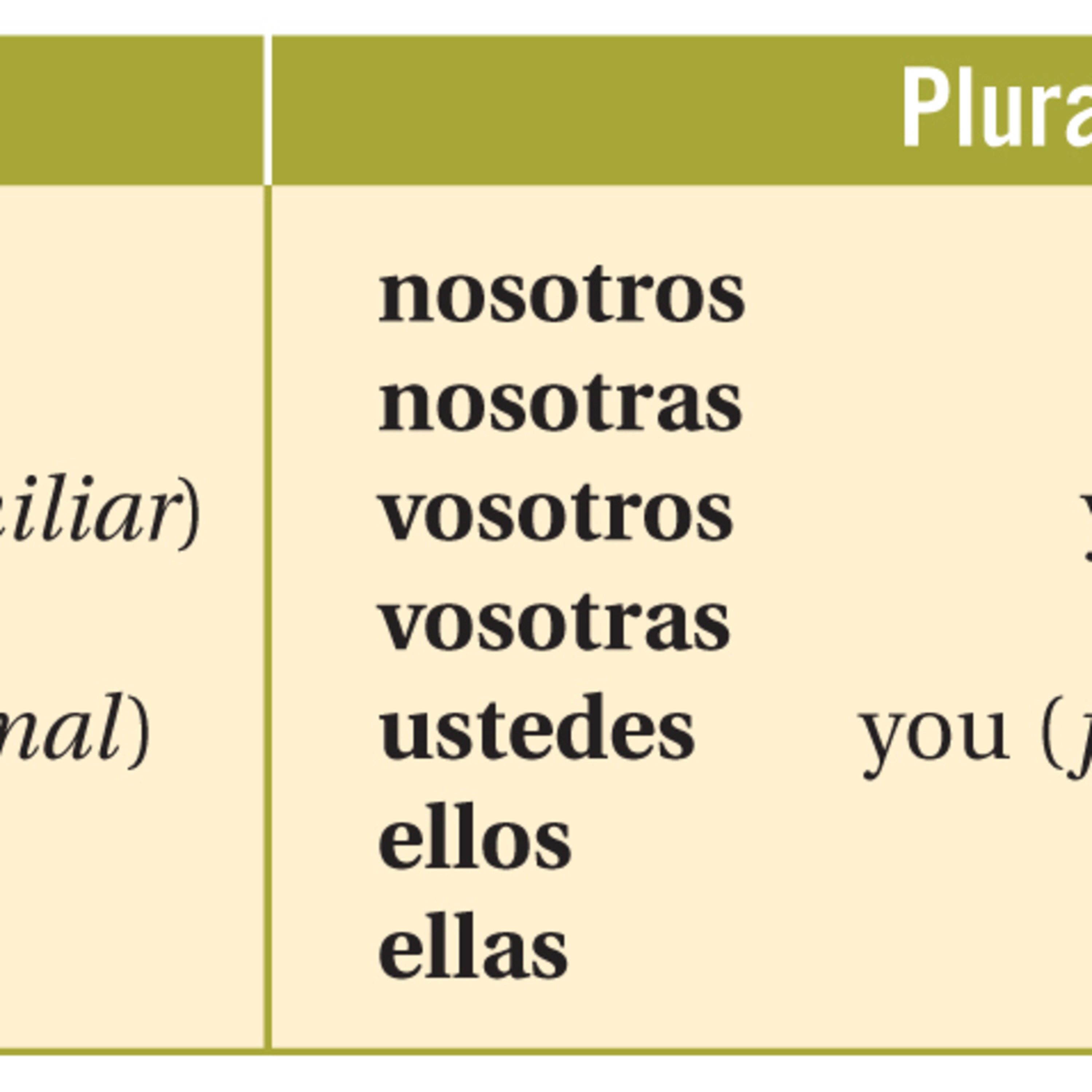 Michele Moore's PodcastSPA111 Fall2012 Subject Pronouns and the Verb SerSUBJECT PRONOUNS
The subject of a sentence, the noun, is the person or thing, which performs the action. The Subject pronoun replaces this person or thing, the noun. Before you can fully understand how to conjugate verbs, you must understand subject pronouns.
ENGLISH
1st person singular I
2nd person singular you
3rd person singular he, she, it
1st person plural we
2nd person plural you (y'all)
3rd person plural they
SPANISH
1st person singular yo
2nd person singular *tú
3rd person singular él, ella, *Ud.
1st person plural nosotros, nosotras
2nd person plural *vosotros, vosotras
3rd person plural ellos, el...2012-09-0526 min
Michele Moore's PodcastSPA111 Fall2012 Subject Pronouns and the Verb SerSUBJECT PRONOUNS
The subject of a sentence, the noun, is the person or thing, which performs the action. The Subject pronoun replaces this person or thing, the noun. Before you can fully understand how to conjugate verbs, you must understand subject pronouns.
ENGLISH
1st person singular I
2nd person singular you
3rd person singular he, she, it
1st person plural we
2nd person plural you (y'all)
3rd person plural they
SPANISH
1st person singular yo
2nd person singular *tú
3rd person singular él, ella, *Ud.
1st person plural nosotros, nosotras
2nd person plural *vosotros, vosotras
3rd person plural ellos, el...2012-09-0526 min Michele Moore's PodcastSPA112: Present Progressive Spring 2013Present Progressive
In English, the present progressive is used to talk about actions that are in progress at a specific moment in time, they are used to emphasize the actual moment that the action is taking place.
The present progressive is formed by combining the verb "to be" with the present participle. (The present participle is simply the "-ing" form of a verb.)
Bob is talking on the phone.
Mom is washing the dishes.
We are leaving at 6am.
In Spanish, the present progressive is formed by using the verb “estar”
Estar – to be
yo estoy
tú estás
Ud., él...2012-09-0425 min
Michele Moore's PodcastSPA112: Present Progressive Spring 2013Present Progressive
In English, the present progressive is used to talk about actions that are in progress at a specific moment in time, they are used to emphasize the actual moment that the action is taking place.
The present progressive is formed by combining the verb "to be" with the present participle. (The present participle is simply the "-ing" form of a verb.)
Bob is talking on the phone.
Mom is washing the dishes.
We are leaving at 6am.
In Spanish, the present progressive is formed by using the verb “estar”
Estar – to be
yo estoy
tú estás
Ud., él...2012-09-0425 min Michele Moore's PodcastSPA212: Relative PronounsRelative Pronouns
Connect or relate 2 clauses and refer to a person or thing in the 1st clause.
Relative Pronouns can be omitted in English, but NOT in Spanish.
Here are the most common relative pronouns:
1. Que: meaning that, which, who or whom
• Most common relative pronoun
• Refers to both people and objects
• It is the only relative pronoun that can be used without a preposition in defining relative clauses
Tuve un examen de español. El examen duró dos horas.
I had a Spanish exam. The exam lasted 2 hours.
Tuve un examen de español que duró dos horas.
I had a Sp...2012-07-1907 min
Michele Moore's PodcastSPA212: Relative PronounsRelative Pronouns
Connect or relate 2 clauses and refer to a person or thing in the 1st clause.
Relative Pronouns can be omitted in English, but NOT in Spanish.
Here are the most common relative pronouns:
1. Que: meaning that, which, who or whom
• Most common relative pronoun
• Refers to both people and objects
• It is the only relative pronoun that can be used without a preposition in defining relative clauses
Tuve un examen de español. El examen duró dos horas.
I had a Spanish exam. The exam lasted 2 hours.
Tuve un examen de español que duró dos horas.
I had a Sp...2012-07-1907 min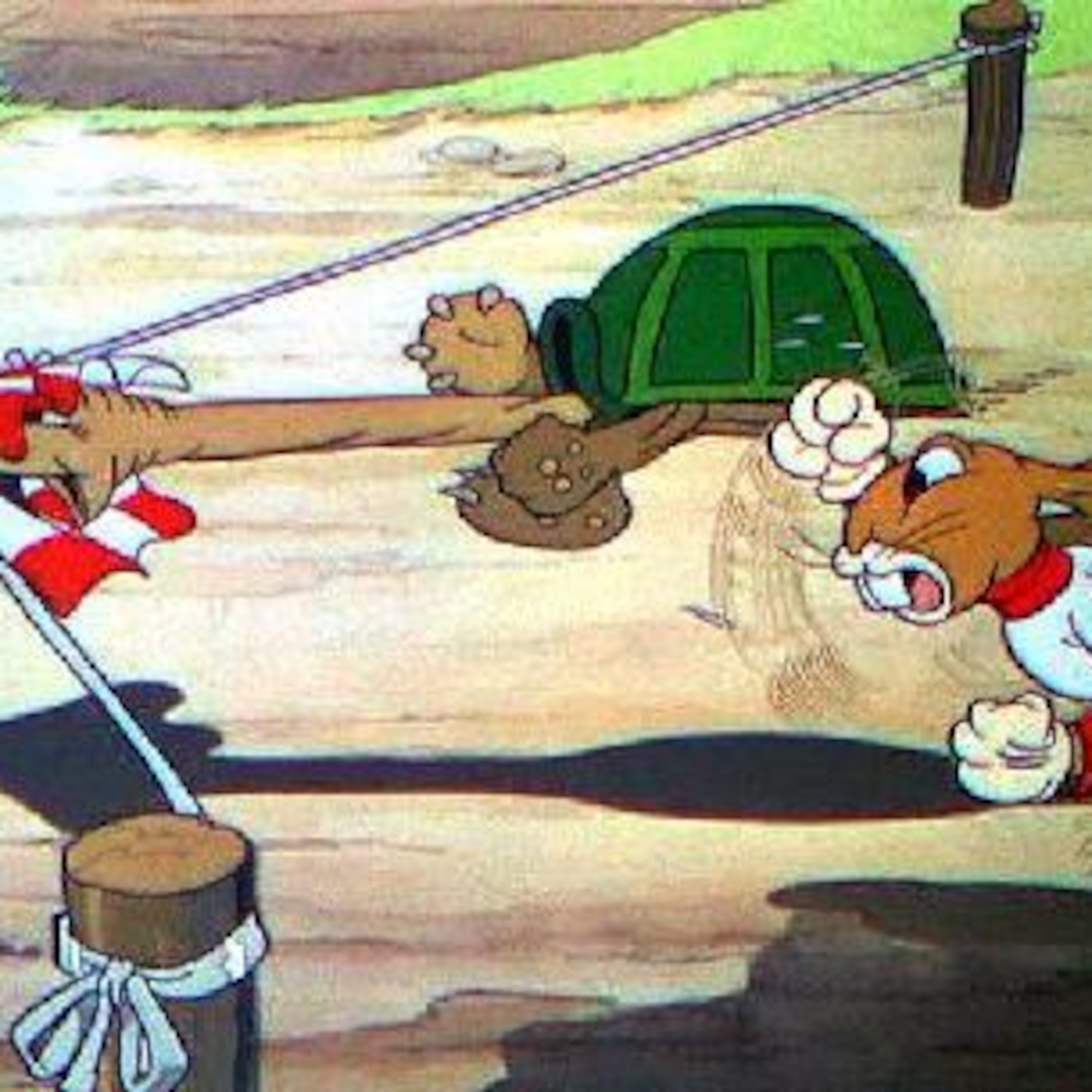 Michele Moore's PodcastSPA212: The ConditionalThe Conditional Tense expresses hypothetical situations
There are 2 tenses: CONDITIONAL PRESENT and CONDITIONAL PERFECT:
Present Conditional is formed by adding the following endings to the INFINITIVE
of the –ar, -er, and –ir verbs.
Yo … -ía … estaría
Tu … -ías … estarías
Ud./él/ella … -ía … estaría
Nosotros … -íamos … estaríamos
Vosotros … -íais … estaríais
Uds./ellos/ellas … -ían … estarían
Remember the few verbs that were irregular in the Future tense? I know you don’t, but anyway the few words that were irregular in the Future are the same verbs irregular in the Conditional:
Here are verbs that dr...2012-07-1807 min
Michele Moore's PodcastSPA212: The ConditionalThe Conditional Tense expresses hypothetical situations
There are 2 tenses: CONDITIONAL PRESENT and CONDITIONAL PERFECT:
Present Conditional is formed by adding the following endings to the INFINITIVE
of the –ar, -er, and –ir verbs.
Yo … -ía … estaría
Tu … -ías … estarías
Ud./él/ella … -ía … estaría
Nosotros … -íamos … estaríamos
Vosotros … -íais … estaríais
Uds./ellos/ellas … -ían … estarían
Remember the few verbs that were irregular in the Future tense? I know you don’t, but anyway the few words that were irregular in the Future are the same verbs irregular in the Conditional:
Here are verbs that dr...2012-07-1807 min Michele Moore's PodcastSPA212: if ClausesIf clauses …
There are 2 types of if clauses…
1. Those that represent a probable situation that is likely to happen or that represent a habitual action
Si estudio, recibiré una “A”. (this could happen)
2. Those that represent situations hypothetical or contrary to the fact
Si estuviera en México, visitaría las ruinas mayas. ( hypothetical)
FORMULAS
Si + present indicative, future OR present. (= probable or habitual)
Si tengo tiempo, iré al cine contigo.
If I have time, I’ll go to the movies with you. (probable.)
Si ella toma buenos apuntes, saca buenas notas.
If she takes good notes, she gets good grades...2012-07-1804 min
Michele Moore's PodcastSPA212: if ClausesIf clauses …
There are 2 types of if clauses…
1. Those that represent a probable situation that is likely to happen or that represent a habitual action
Si estudio, recibiré una “A”. (this could happen)
2. Those that represent situations hypothetical or contrary to the fact
Si estuviera en México, visitaría las ruinas mayas. ( hypothetical)
FORMULAS
Si + present indicative, future OR present. (= probable or habitual)
Si tengo tiempo, iré al cine contigo.
If I have time, I’ll go to the movies with you. (probable.)
Si ella toma buenos apuntes, saca buenas notas.
If she takes good notes, she gets good grades...2012-07-1804 min Michele Moore's PodcastSPA211: Imperfect SubjunctiveThe imperfect subjunctive is used under the same circumstances as the present subjunctive, except the situation is referring to the past. Remember the subjunctive is a mood used to express a wish, hope, uncertainty or other attitudes toward a fact or idea.
You’ll love conjugating the imperfect subjunctive, because the conjugations are formed by dropping –ron from the 3rd person plural form of the preterit. PLUS the endings are the SAME for the –ar, -er, and the –ir verbs.
2 forms:
• The –ra form is used in Spain and Latin America
• The –se form is used primarily in Spain and more common...2012-07-1807 min
Michele Moore's PodcastSPA211: Imperfect SubjunctiveThe imperfect subjunctive is used under the same circumstances as the present subjunctive, except the situation is referring to the past. Remember the subjunctive is a mood used to express a wish, hope, uncertainty or other attitudes toward a fact or idea.
You’ll love conjugating the imperfect subjunctive, because the conjugations are formed by dropping –ron from the 3rd person plural form of the preterit. PLUS the endings are the SAME for the –ar, -er, and the –ir verbs.
2 forms:
• The –ra form is used in Spain and Latin America
• The –se form is used primarily in Spain and more common...2012-07-1807 min Michele Moore's PodcastSPA211: Formation of AdverbsAdverbs are words that qualify or modify verbs, adjectives, or other adverbs.
Adverbs express manner, time, place, quantity, degree, doubt, affirmation, or negation.
Adverbs of manner show the way in which something is done or happens
• Most adverbs are formed by adding –mente (the equivalent of the English –ly) to the adjective
• Adjectives ending in –o change the –o to –a before adding –mente
o Lento … lentamente = slowly
• Adjectives ending in –a, -e, or a consonant, add –mente directly to the form.
o Probable … probablemente = probably
• Adjectives with a written accent mark, keep the accent mark when they become adverbs
o Fácil … fácilment...2012-07-1705 min
Michele Moore's PodcastSPA211: Formation of AdverbsAdverbs are words that qualify or modify verbs, adjectives, or other adverbs.
Adverbs express manner, time, place, quantity, degree, doubt, affirmation, or negation.
Adverbs of manner show the way in which something is done or happens
• Most adverbs are formed by adding –mente (the equivalent of the English –ly) to the adjective
• Adjectives ending in –o change the –o to –a before adding –mente
o Lento … lentamente = slowly
• Adjectives ending in –a, -e, or a consonant, add –mente directly to the form.
o Probable … probablemente = probably
• Adjectives with a written accent mark, keep the accent mark when they become adverbs
o Fácil … fácilment...2012-07-1705 min Michele Moore's PodcastSPA211: The Subjunctive: DOUBTAs you know, the subjunctive is a “mood” rather than a tense. It is an attitude that the speaker has toward a fact or action, in which the outcome is not certain. It represents hypothetical situations or contingency. Whereas with the indicative, we had fact and certainty, with the subjunctive we don’t.
In this section, we will learn how the subjunctive is used to express doubt, denial and disbelief.
DOUBT
When the verb of the main clause expresses uncertainty or doubt, the verb in the subordinate clause is in the subjunctive.
I doubt that I can be there at that t...2012-07-0309 min
Michele Moore's PodcastSPA211: The Subjunctive: DOUBTAs you know, the subjunctive is a “mood” rather than a tense. It is an attitude that the speaker has toward a fact or action, in which the outcome is not certain. It represents hypothetical situations or contingency. Whereas with the indicative, we had fact and certainty, with the subjunctive we don’t.
In this section, we will learn how the subjunctive is used to express doubt, denial and disbelief.
DOUBT
When the verb of the main clause expresses uncertainty or doubt, the verb in the subordinate clause is in the subjunctive.
I doubt that I can be there at that t...2012-07-0309 min Michele Moore's PodcastSPA211: The Subjunctive part 1Subjunctive
The subjunctive is a “verbal mood” rather than a tense. It is an attitude that the speaker has toward a fact or action, in which the outcome is not certain. It represents hypothetical situations or contingency. Up until now we have been working with the Indicative, in which the verbs expressed events or stated things that are considered factual, definite, or part of a reality as expressed by the speaker.
Now with the Subjunctive that certainty isn’t there.
1. It is used to express:
Doubt I doubt that you are going to Spain this summer.
Desire I hope we can...2012-06-2708 min
Michele Moore's PodcastSPA211: The Subjunctive part 1Subjunctive
The subjunctive is a “verbal mood” rather than a tense. It is an attitude that the speaker has toward a fact or action, in which the outcome is not certain. It represents hypothetical situations or contingency. Up until now we have been working with the Indicative, in which the verbs expressed events or stated things that are considered factual, definite, or part of a reality as expressed by the speaker.
Now with the Subjunctive that certainty isn’t there.
1. It is used to express:
Doubt I doubt that you are going to Spain this summer.
Desire I hope we can...2012-06-2708 min Michele Moore's PodcastSPA211: The FutureThe Future tense is the a tense that expresses actions that have not yet occurred… the future
It is the equivalent of will or shall + verb in English
I will study in Mexico this summer. Estudiaré en México este verano.
Will you buy a new car this fall? ¿Comprarás un coche nuevo este otoño?
The Future is also used to express conjecture or probability
There will be a party this weekend. Habrá una fiesta este fin de semana.
I wonder what time it is? ¿Qué hora será?
It’s probably 2pm. Serán las dos
There are 3 great th...2012-06-2610 min
Michele Moore's PodcastSPA211: The FutureThe Future tense is the a tense that expresses actions that have not yet occurred… the future
It is the equivalent of will or shall + verb in English
I will study in Mexico this summer. Estudiaré en México este verano.
Will you buy a new car this fall? ¿Comprarás un coche nuevo este otoño?
The Future is also used to express conjecture or probability
There will be a party this weekend. Habrá una fiesta este fin de semana.
I wonder what time it is? ¿Qué hora será?
It’s probably 2pm. Serán las dos
There are 3 great th...2012-06-2610 min Michele Moore's PodcastSPA211: Preterit and the ImperfectPreterit
1. For actions that can be viewed as single events
2. For actions that were repeated a specific number of times
3. For actions that occurred during a specific period of time
4. For actions that were part of a chain of events
5. To state the beginning or the end of an action
Imperfect
1. For actions that were repeated habitually
2. For actions that "set the stage" for another past action
3. For telling time
4. For stating one's age
5. For mental states (usually)
6. For physical sensations (usually)
7. To describe the characteristics of people, things or conditions
PRETERIT Conjugations
Singular
1st person (yo) -ar...é -er...2012-06-0504 min
Michele Moore's PodcastSPA211: Preterit and the ImperfectPreterit
1. For actions that can be viewed as single events
2. For actions that were repeated a specific number of times
3. For actions that occurred during a specific period of time
4. For actions that were part of a chain of events
5. To state the beginning or the end of an action
Imperfect
1. For actions that were repeated habitually
2. For actions that "set the stage" for another past action
3. For telling time
4. For stating one's age
5. For mental states (usually)
6. For physical sensations (usually)
7. To describe the characteristics of people, things or conditions
PRETERIT Conjugations
Singular
1st person (yo) -ar...é -er...2012-06-0504 min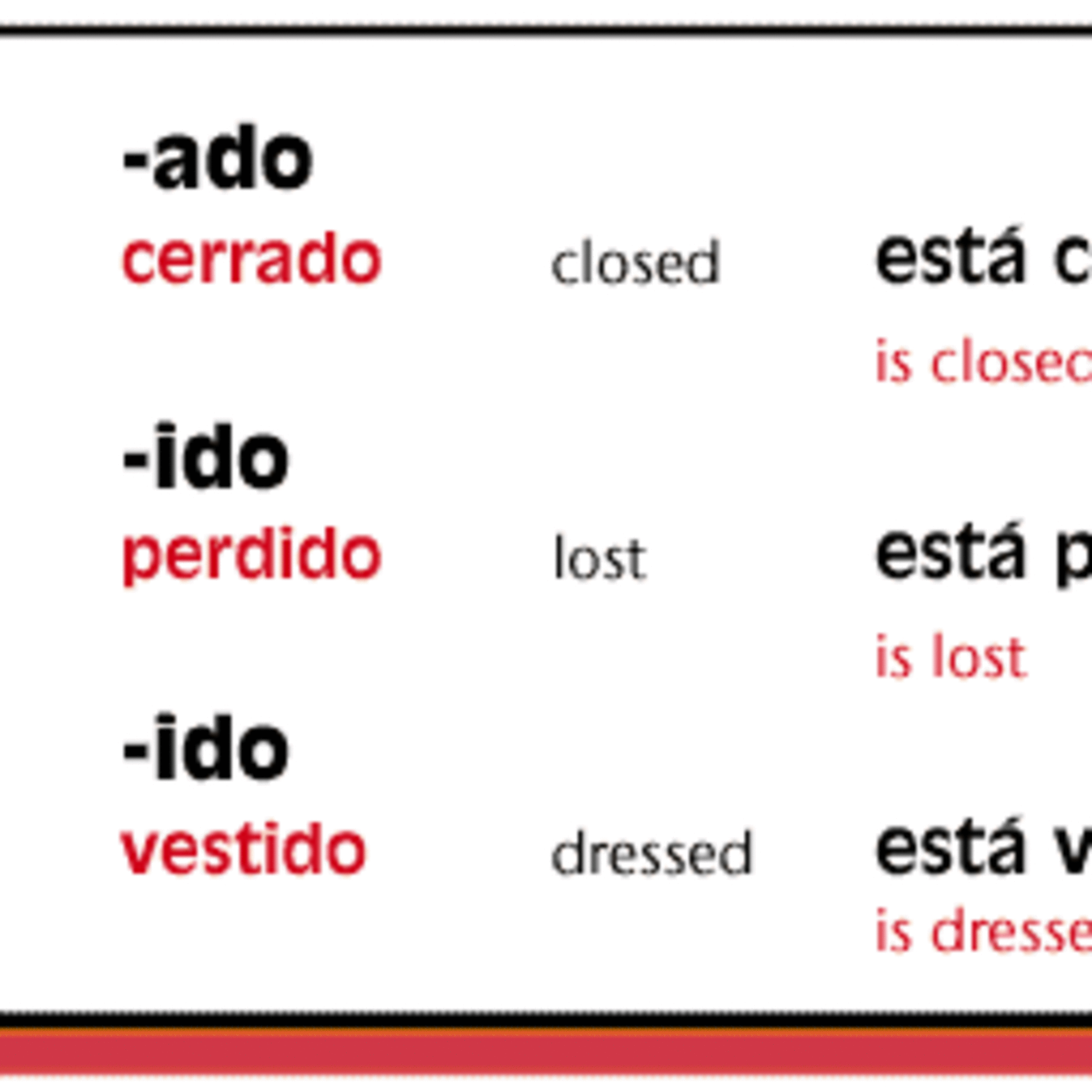 Michele Moore's PodcastSPA211: Past ParticiplesPast Participles
The form of the verb that implies completion. The action described by the verb is completed with respect to a specific point in time.
Formed by dropping the ending and adding
-ado to the stem of -ar verbs
-ido to the stem of -er and -ir verbs
Used the same way in Spanish as in English
1. We have always loved animals. (-ed form)
Siempre hemos querido a los animales.
2. I have given him my car. (-en form/passive voice)
Le he dado mi coche.
Irregular Past Participles
abrir... to open... abierto
decir... to say... dicho
hacer... to...2012-06-0505 min
Michele Moore's PodcastSPA211: Past ParticiplesPast Participles
The form of the verb that implies completion. The action described by the verb is completed with respect to a specific point in time.
Formed by dropping the ending and adding
-ado to the stem of -ar verbs
-ido to the stem of -er and -ir verbs
Used the same way in Spanish as in English
1. We have always loved animals. (-ed form)
Siempre hemos querido a los animales.
2. I have given him my car. (-en form/passive voice)
Le he dado mi coche.
Irregular Past Participles
abrir... to open... abierto
decir... to say... dicho
hacer... to...2012-06-0505 min Michele Moore's PodcastSPA111 Vocabulary: Los trabajos de la casaLos trabajos de la casa
Cognados
El desastre day sas tray
La ensalada ain sa la da
La excusa eggs coo sa
La familia fa meal ya
El garaje ga ra hay
La limonada lee mown ah da
El momento mo main toe
La ocupación oh coo pa see own
El refrigerador ray free hair a door
Adjetivos
Este(a) ay stay (ay sta)
Mandón(dona) mand own (mand own ah)
Ocupado(a) oh coo pah doe (oh coo pah dah)
Nombres
El baño, el cuarto de baño ban yo, kwar toe * day * ban yo
La b...2012-03-2814 min
Michele Moore's PodcastSPA111 Vocabulary: Los trabajos de la casaLos trabajos de la casa
Cognados
El desastre day sas tray
La ensalada ain sa la da
La excusa eggs coo sa
La familia fa meal ya
El garaje ga ra hay
La limonada lee mown ah da
El momento mo main toe
La ocupación oh coo pa see own
El refrigerador ray free hair a door
Adjetivos
Este(a) ay stay (ay sta)
Mandón(dona) mand own (mand own ah)
Ocupado(a) oh coo pah doe (oh coo pah dah)
Nombres
El baño, el cuarto de baño ban yo, kwar toe * day * ban yo
La b...2012-03-2814 min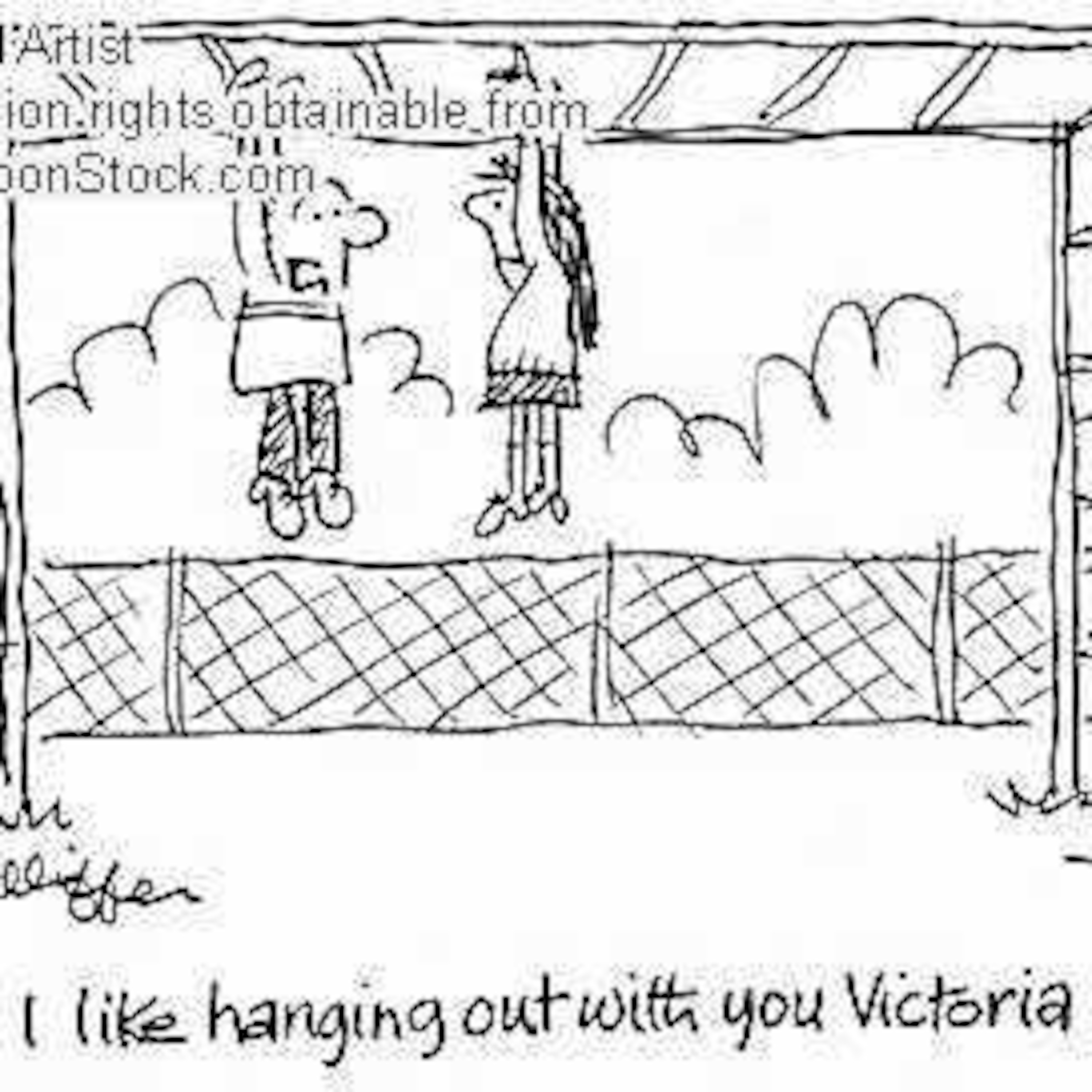 Michele Moore's PodcastSPA112 Lesson 7 VocabularyCOGNADOS
El beisbol…bAYS bol
La discoteca…dee co tay ca
Moderno(a)…mo dair no
El permiso…pair me so
El plan…plahn
El teatro…tay at row
La visita…bee see ta
NOMBRES
El cine…see nay…movie theatre
El fin de semana…feen * day * say mah nah…weekend
El florero…floor air oh…base
La medianoche…may dee ah no chay…midnight
El partido…par tee doe…game
El juego…way go…game
La película…pay lee coo la…movie, film
La semana…say mah nah
La vez…bays…time
VERBOS
Aburrirse…ah bor rear say…to be bored
Bromear…bro me ahr…to kid, to joke
...2012-03-2619 min
Michele Moore's PodcastSPA112 Lesson 7 VocabularyCOGNADOS
El beisbol…bAYS bol
La discoteca…dee co tay ca
Moderno(a)…mo dair no
El permiso…pair me so
El plan…plahn
El teatro…tay at row
La visita…bee see ta
NOMBRES
El cine…see nay…movie theatre
El fin de semana…feen * day * say mah nah…weekend
El florero…floor air oh…base
La medianoche…may dee ah no chay…midnight
El partido…par tee doe…game
El juego…way go…game
La película…pay lee coo la…movie, film
La semana…say mah nah
La vez…bays…time
VERBOS
Aburrirse…ah bor rear say…to be bored
Bromear…bro me ahr…to kid, to joke
...2012-03-2619 min Michele Moore's PodcastSPA112: Interrogative, Affirmative, and NegativeInterrogative, negative, and affirmative sentences
Interrogative
An interrogative sentence asks a question. In English, you can form an interrogative sentence by
1. Adding a helping verb, like do, does, or did before the verb.
Do Sally and Bob eat meat?
Does Joe run everyday?
Did the children finish their homework?
2. Inverting the word order of a statement.
Sally is in Chicago. Is Sally in Chicago?
In Spanish, a simple statement can be made an interrogative by inverting the word order.
Bob habla español. Bob speaks Spanish. ¿Habla español Bob? Does Bob speak Spanish?
Jack Johnson canta. Jack Johnson sin...2012-03-1424 min
Michele Moore's PodcastSPA112: Interrogative, Affirmative, and NegativeInterrogative, negative, and affirmative sentences
Interrogative
An interrogative sentence asks a question. In English, you can form an interrogative sentence by
1. Adding a helping verb, like do, does, or did before the verb.
Do Sally and Bob eat meat?
Does Joe run everyday?
Did the children finish their homework?
2. Inverting the word order of a statement.
Sally is in Chicago. Is Sally in Chicago?
In Spanish, a simple statement can be made an interrogative by inverting the word order.
Bob habla español. Bob speaks Spanish. ¿Habla español Bob? Does Bob speak Spanish?
Jack Johnson canta. Jack Johnson sin...2012-03-1424 min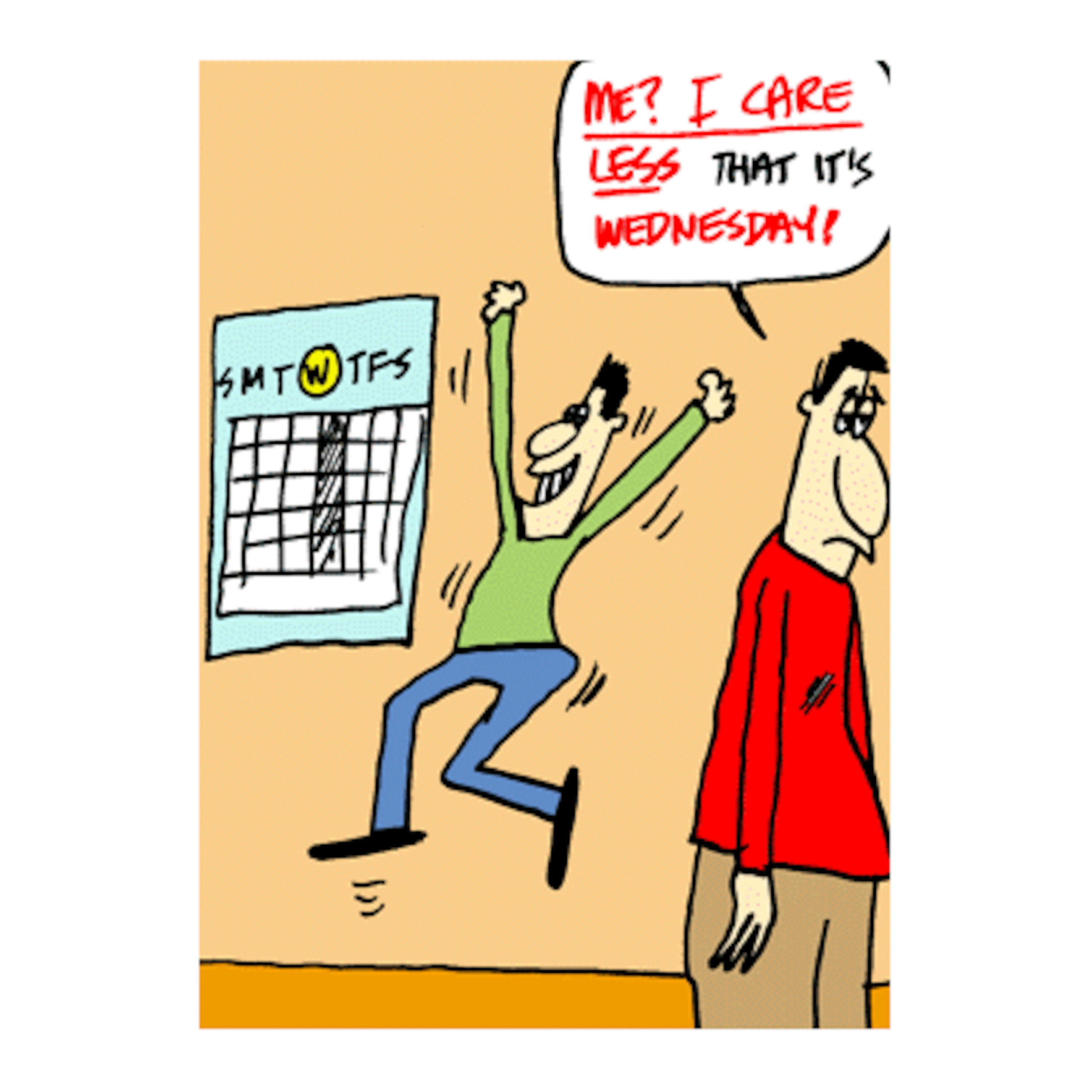 Michele Moore's PodcastSPA111: Calendar VocabularyLos días de la semana / The days of the week
Monday ... el lunes ... loon ace
Tuesday ... el martes ... mar tace
Wednesday ... el miércoles ... me air co lace
Thursday ... el jueves ... way bace
Friday ... el viernes ... bee air nace
Saturday ... el sábado ... sa ba doe
Sunday ... el domingo ... doe mingo
In Spanish-speaking countries, the week begins on Monday.
***They are not capitalized and they are all masculine.
“El” and “los” when used with the days of the week mean "on."
Voy a la escuela los lunes y los miércoles.
I go to school on Mondays and Wednesdays.
...2012-03-1413 min
Michele Moore's PodcastSPA111: Calendar VocabularyLos días de la semana / The days of the week
Monday ... el lunes ... loon ace
Tuesday ... el martes ... mar tace
Wednesday ... el miércoles ... me air co lace
Thursday ... el jueves ... way bace
Friday ... el viernes ... bee air nace
Saturday ... el sábado ... sa ba doe
Sunday ... el domingo ... doe mingo
In Spanish-speaking countries, the week begins on Monday.
***They are not capitalized and they are all masculine.
“El” and “los” when used with the days of the week mean "on."
Voy a la escuela los lunes y los miércoles.
I go to school on Mondays and Wednesdays.
...2012-03-1413 min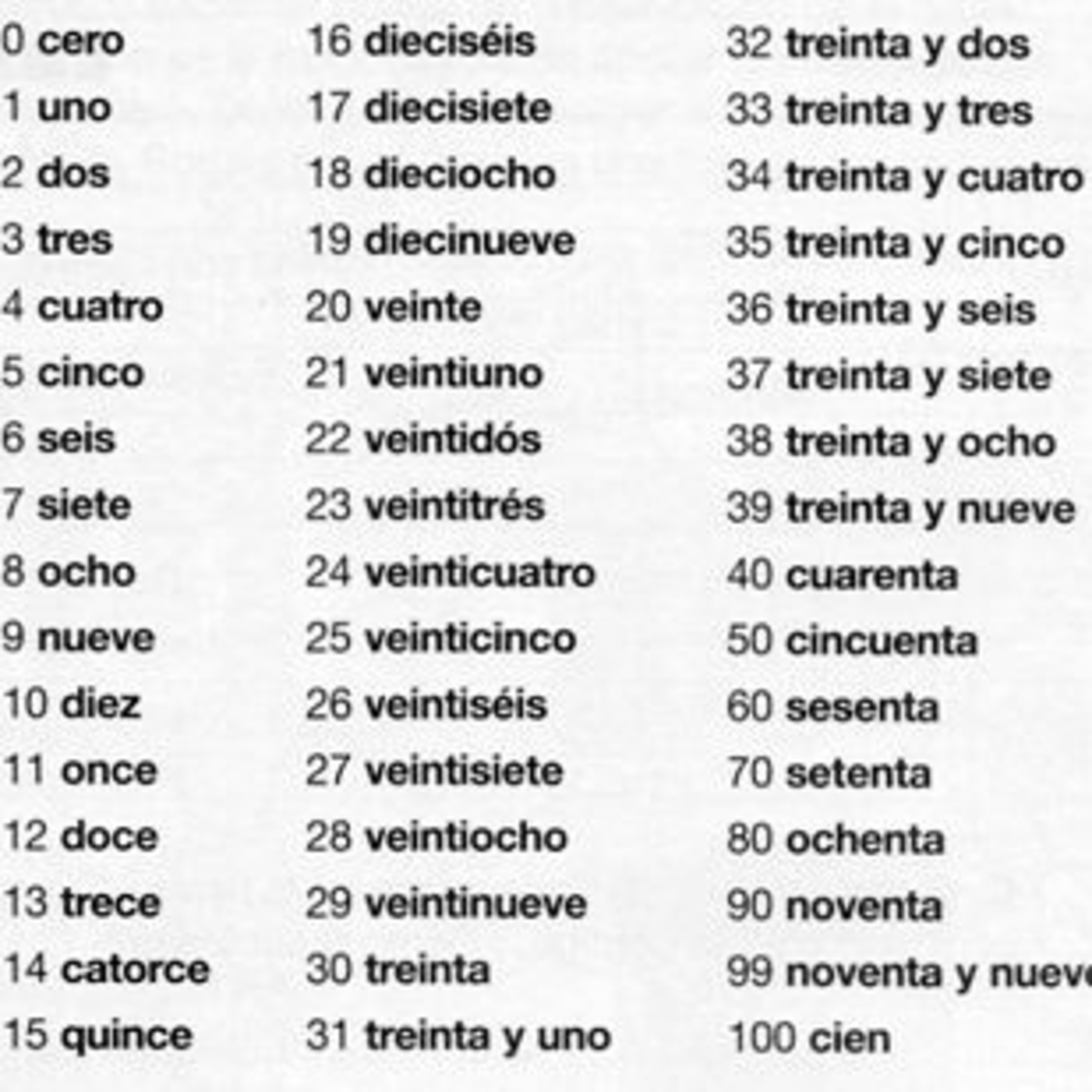 Michele Moore's PodcastSPA111: Numbers 40-200 NÚMEROS PRONUNCIACIÓN
40 cuarenta Kwa rain ta
41 cuarenta y uno Kwa rain ta ee oo no
45 cuarenta y cinco Kwa rain ta ee sink oh
50 cincuenta Seen kwain ta
51 cincuenta y uno Seen kwain ta ee oo no
60 sesenta Say sin ta
70 setenta Say tin ta
80 ochenta Owe shin ta
90 noventa No bin ta
100 cien See in
101 ciento uno See in toe oo no
115 ciento quince See in toe keen say
175 ciento setenta y cinco See in toe say tin ta ee sink oh
180 ciento ochenta See in toe owe shin ta
200 doscientos Dos see in toes2012-03-0805 min
Michele Moore's PodcastSPA111: Numbers 40-200 NÚMEROS PRONUNCIACIÓN
40 cuarenta Kwa rain ta
41 cuarenta y uno Kwa rain ta ee oo no
45 cuarenta y cinco Kwa rain ta ee sink oh
50 cincuenta Seen kwain ta
51 cincuenta y uno Seen kwain ta ee oo no
60 sesenta Say sin ta
70 setenta Say tin ta
80 ochenta Owe shin ta
90 noventa No bin ta
100 cien See in
101 ciento uno See in toe oo no
115 ciento quince See in toe keen say
175 ciento setenta y cinco See in toe say tin ta ee sink oh
180 ciento ochenta See in toe owe shin ta
200 doscientos Dos see in toes2012-03-0805 min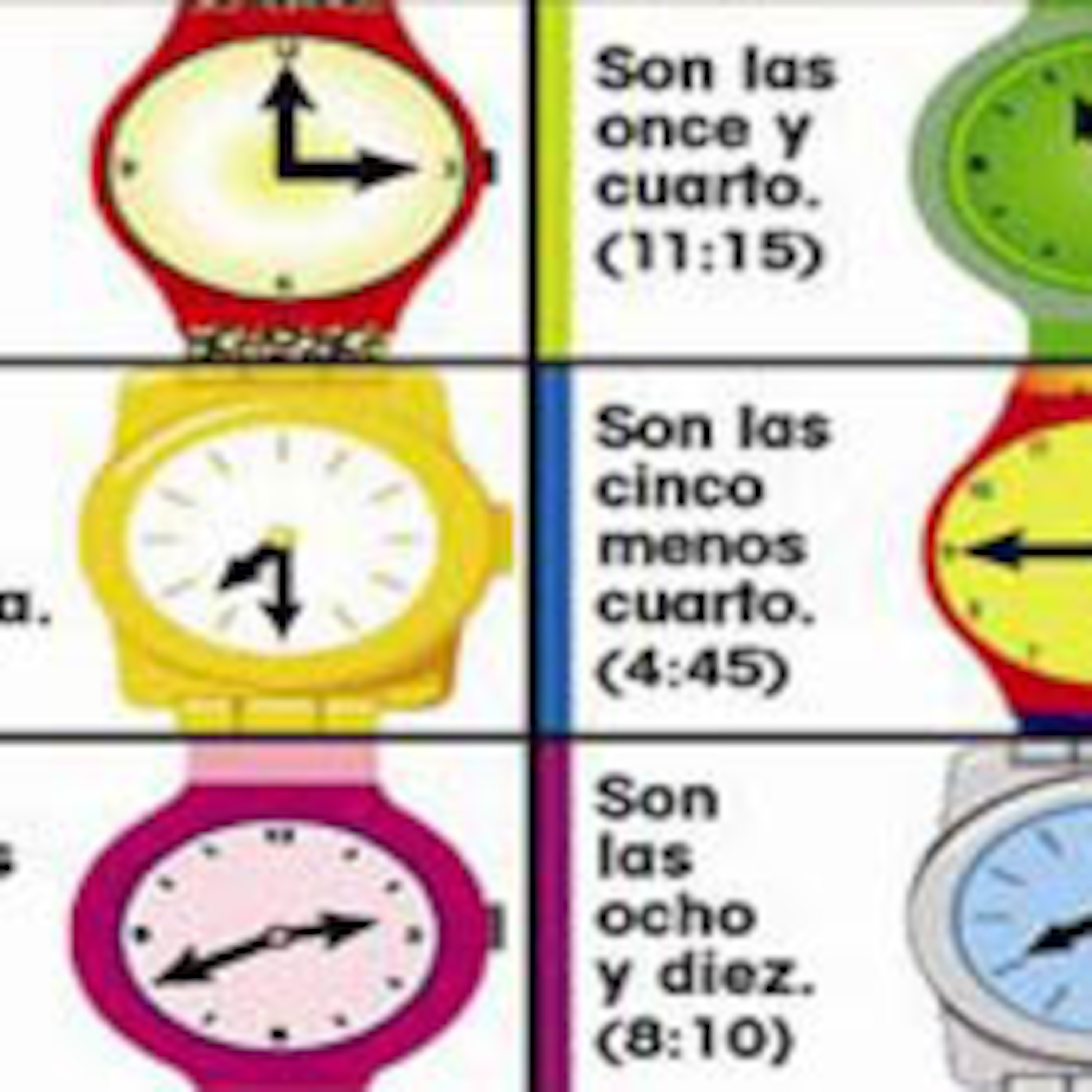 Michele Moore's PodcastSPA111: TimeTelling Time
The verb “ser” is used when referring to time. The following word order should help you:
Es la/Son las + Hour + Y/o/menos + Minutes
Es is used with una …1:00 – 1:59
Son is used with all of the rest of the hours.
La and las are used because they refer to “hora” which is feminine.
Es la una. It’s 1:00. (It is 1 hour.)
Notice***gender and number agreement
Son las tres. It’s 3:00. (It is 3 hours.)
Minutes can be added to the hour using “y”.
Es la una y diez.
It’s 1:10. (It’s 1hr and 10 minutes. Or, it’s 10 after/past 1.)
...2012-03-0815 min
Michele Moore's PodcastSPA111: TimeTelling Time
The verb “ser” is used when referring to time. The following word order should help you:
Es la/Son las + Hour + Y/o/menos + Minutes
Es is used with una …1:00 – 1:59
Son is used with all of the rest of the hours.
La and las are used because they refer to “hora” which is feminine.
Es la una. It’s 1:00. (It is 1 hour.)
Notice***gender and number agreement
Son las tres. It’s 3:00. (It is 3 hours.)
Minutes can be added to the hour using “y”.
Es la una y diez.
It’s 1:10. (It’s 1hr and 10 minutes. Or, it’s 10 after/past 1.)
...2012-03-0815 min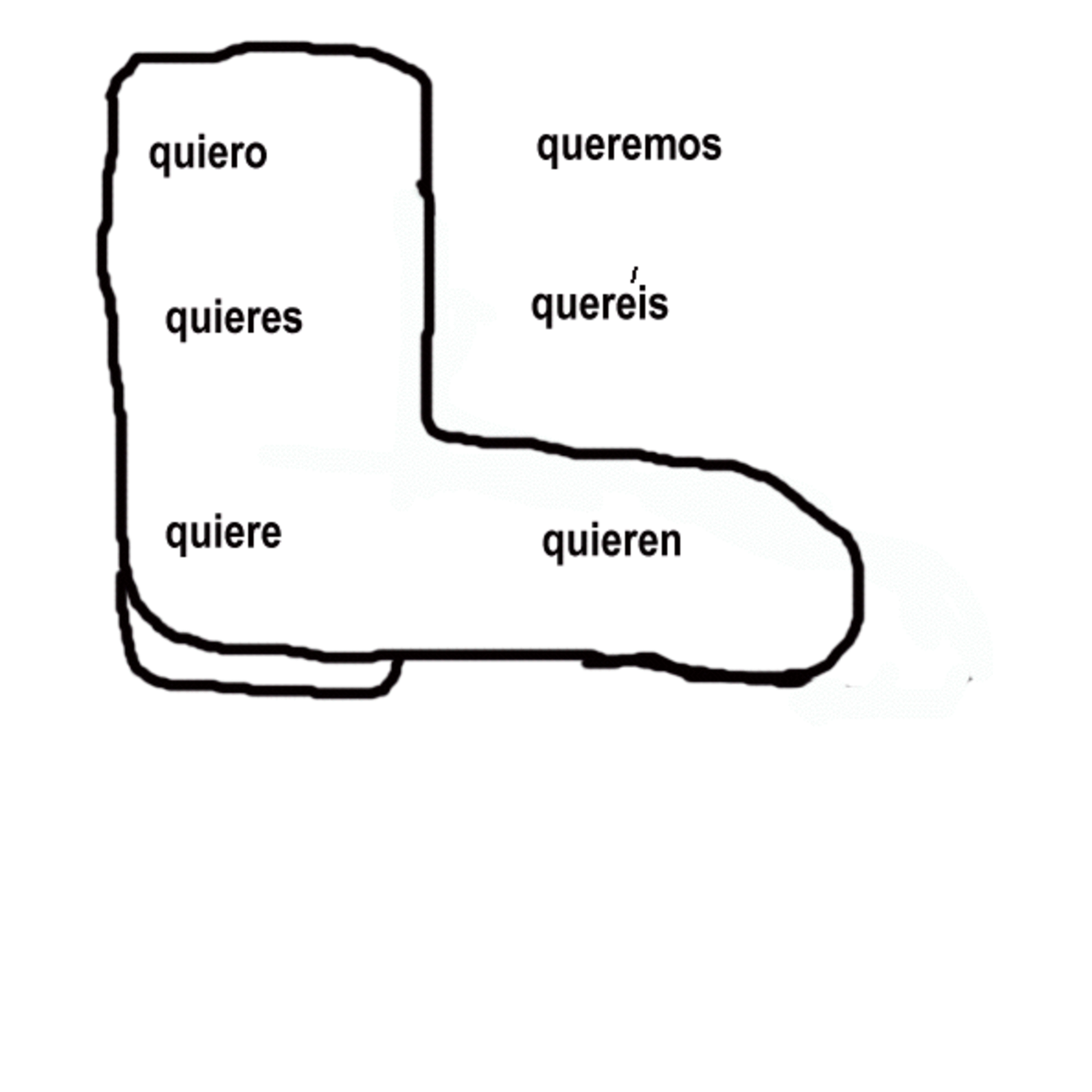 Michele Moore's PodcastSPA112: Stem Change Verbs o-ue and e-iSTEM CHANGING VERBS
Remember, there are three types of infinitives: -ar, -er, -ir. Infinitives are made up of two parts: the ending and the stem. You already know how to conjugate verbs in the present tense, so the actual conjugation is easy. With stem change verbs we are adding the step of making a small vowel spelling change in the stem in all forms of the conjugation except the nosotros and vosotros.
In the present tense, there are three groups of stem-changing verbs: e-ie, o-ue, and e-i.
When this happens you use the 2nd e for the stem change
...2012-02-2117 min
Michele Moore's PodcastSPA112: Stem Change Verbs o-ue and e-iSTEM CHANGING VERBS
Remember, there are three types of infinitives: -ar, -er, -ir. Infinitives are made up of two parts: the ending and the stem. You already know how to conjugate verbs in the present tense, so the actual conjugation is easy. With stem change verbs we are adding the step of making a small vowel spelling change in the stem in all forms of the conjugation except the nosotros and vosotros.
In the present tense, there are three groups of stem-changing verbs: e-ie, o-ue, and e-i.
When this happens you use the 2nd e for the stem change
...2012-02-2117 min Michele Moore's PodcastSPA112: El Mercado vocabularyHere is a link to our notes
http://mymoodle.sampsoncc.edu/mod/resource/view.php?id=325522012-02-2115 min
Michele Moore's PodcastSPA112: El Mercado vocabularyHere is a link to our notes
http://mymoodle.sampsoncc.edu/mod/resource/view.php?id=325522012-02-2115 min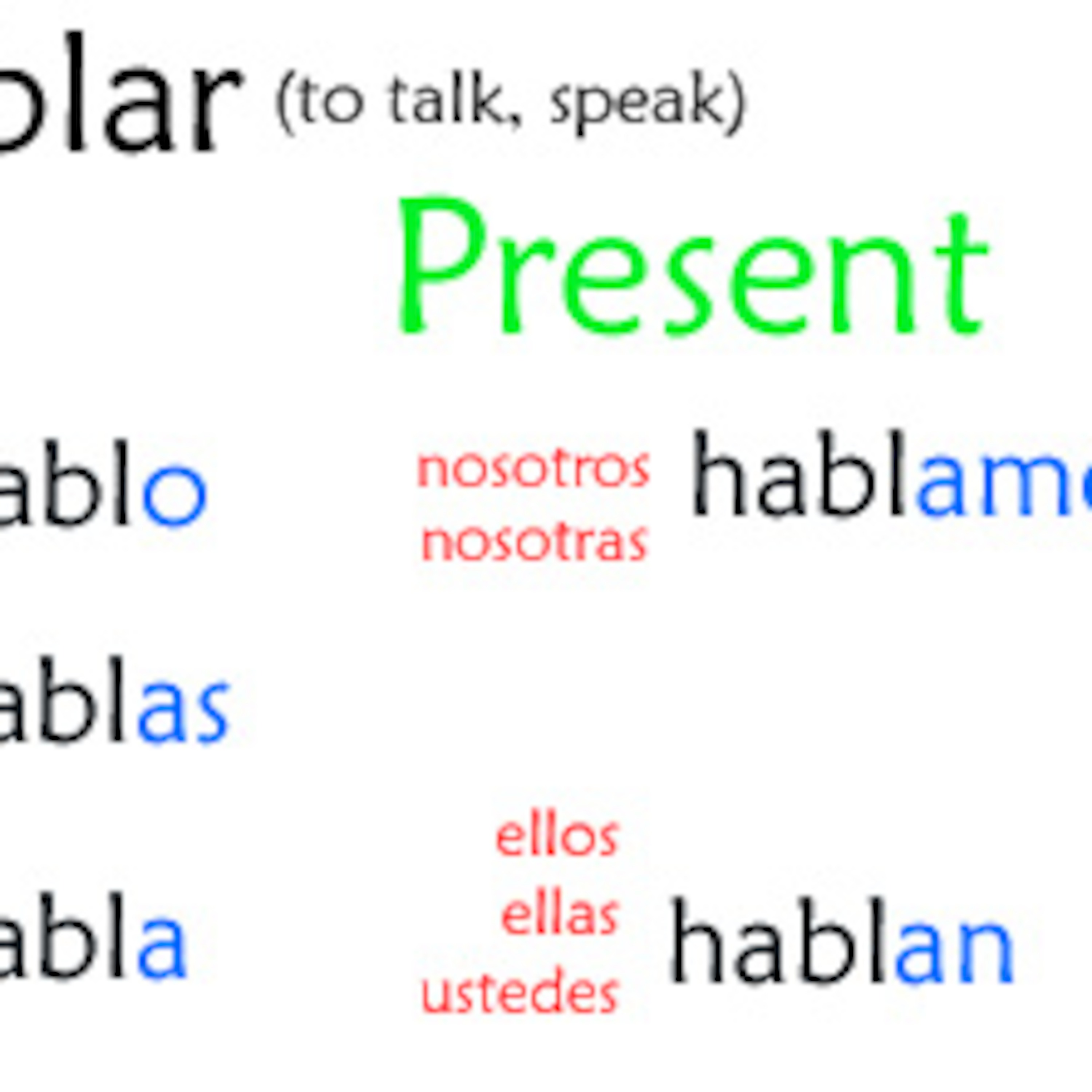 Michele Moore's PodcastSPA111: Conjugating AR VerbsA verb is a word that takes the action of a sentence. In English the infinitive is the name of the verb plus the word “to.” It is considered to be the most basic form of the verb...to eat, to drink, to sleep.
In Spanish, the infinitives end in -ar, -er, or -ir.
I personally think conjugating verbs is like solving a puzzle. Once you have learned and mastered the conjugation of present tense verbs, you’ll be able to conjugate millions…slightly dramatic, lots of Spanish verbs.
Believe it or not we conjugate words everyday in English, we have...2012-02-1612 min
Michele Moore's PodcastSPA111: Conjugating AR VerbsA verb is a word that takes the action of a sentence. In English the infinitive is the name of the verb plus the word “to.” It is considered to be the most basic form of the verb...to eat, to drink, to sleep.
In Spanish, the infinitives end in -ar, -er, or -ir.
I personally think conjugating verbs is like solving a puzzle. Once you have learned and mastered the conjugation of present tense verbs, you’ll be able to conjugate millions…slightly dramatic, lots of Spanish verbs.
Believe it or not we conjugate words everyday in English, we have...2012-02-1612 min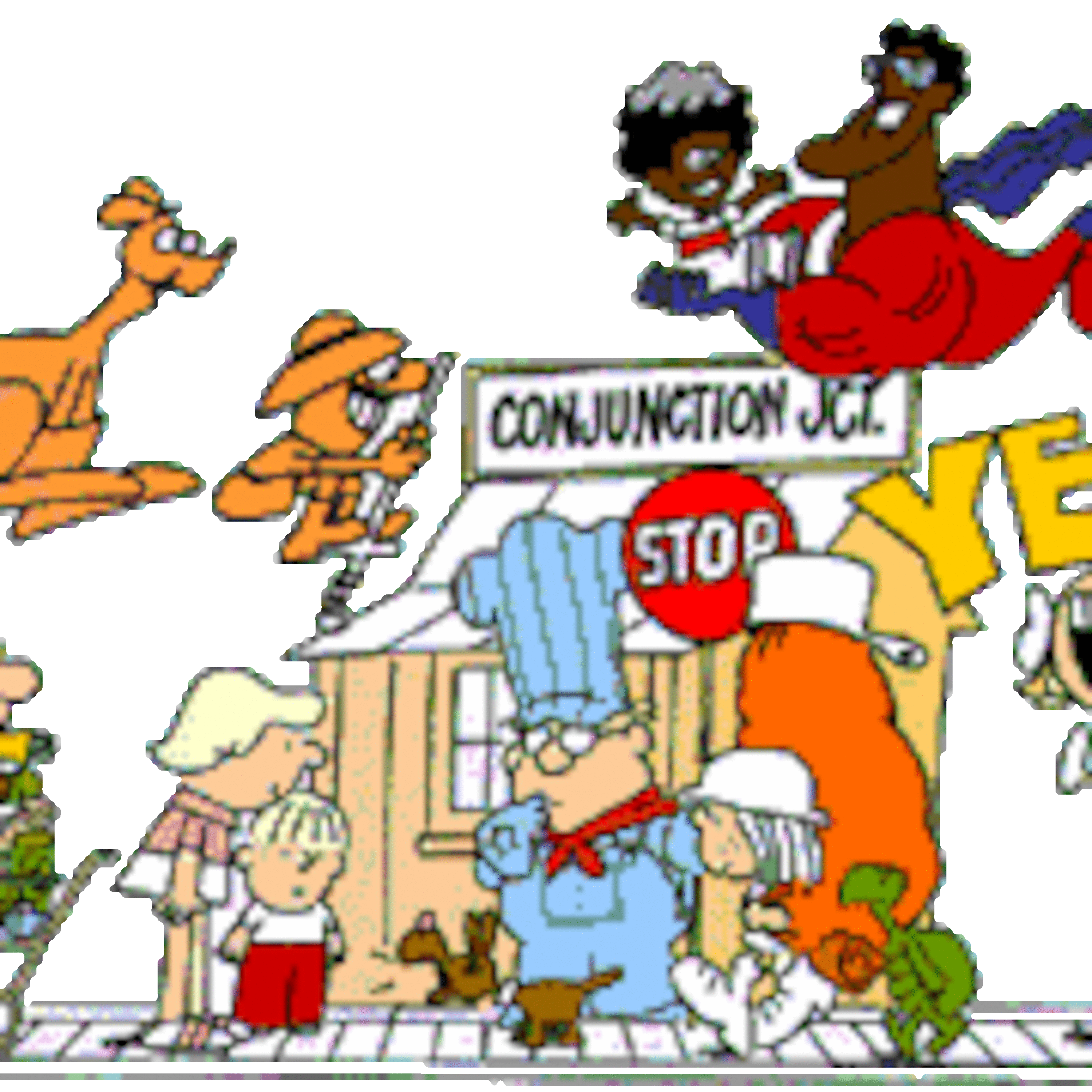 Michele Moore's PodcastSPA111: Nuestras Clases vocabularyNombres
el (la) aguafiestas ** ah gwa fee ace tahs
el (la) amigo(a)** ah mee go
la asignatura ** ah seeg na tour ah
el aula ** awww la
el café ** caf AY
el dinero ** dee nair oh
el horario de clases ** or are ee oh day clas says
el inglés ** ing lace
el lunes ** loon ace
la leche ** lay chay
el miércoles ** me air co lace
la noche ** no chay
la playa ** ply ya
el requisito ** ray key see toe
la química ** key me ka
la tarde ** tar day
la taza ** tah za
el vaso ** bah so
el v...2012-02-1417 min
Michele Moore's PodcastSPA111: Nuestras Clases vocabularyNombres
el (la) aguafiestas ** ah gwa fee ace tahs
el (la) amigo(a)** ah mee go
la asignatura ** ah seeg na tour ah
el aula ** awww la
el café ** caf AY
el dinero ** dee nair oh
el horario de clases ** or are ee oh day clas says
el inglés ** ing lace
el lunes ** loon ace
la leche ** lay chay
el miércoles ** me air co lace
la noche ** no chay
la playa ** ply ya
el requisito ** ray key see toe
la química ** key me ka
la tarde ** tar day
la taza ** tah za
el vaso ** bah so
el v...2012-02-1417 min Michele Moore's PodcastSPA112: Superlatives (Review)Superlatives
To form the superlative use the following:
definite article + noun + más o menos + adjective + de
1. Juan es el chico más inteligente de la clase.
John is the smartest boy in the class.
2. Bill Gates es el hombre más rico de los EEUU.
Bill Gates is the richest man in the U.S.
3. Mario es el más inteligente de todos.
Mario is the most intelligent of all.
**Notice in the last example, that the noun is omitted. If the meaning is clear from context, the repetition of the noun is not needed.
** de can be tran...2012-02-0905 min
Michele Moore's PodcastSPA112: Superlatives (Review)Superlatives
To form the superlative use the following:
definite article + noun + más o menos + adjective + de
1. Juan es el chico más inteligente de la clase.
John is the smartest boy in the class.
2. Bill Gates es el hombre más rico de los EEUU.
Bill Gates is the richest man in the U.S.
3. Mario es el más inteligente de todos.
Mario is the most intelligent of all.
**Notice in the last example, that the noun is omitted. If the meaning is clear from context, the repetition of the noun is not needed.
** de can be tran...2012-02-0905 min Michele Moore's PodcastSPA112: Comparisons of EqualitiesComparisons of equality
A. To form the comparisons of equality using adjectives or adverbs, use the following:
tan (as) + adjective/adverb + como (as)
1. El libro es tan bueno como la película.
The book is as good as the movie.
2. El chico es tan alto como la chica.
The boy is as tall as the girl.
B. To form the comparisons of equality using nouns, use the following:
tanto (as much) + noun=masculine, singular + como (as)
tanta + noun=feminine, singular
tantos + noun=masculine,plural
tantas + noun=feminine, plural
C. When actions (verbs) are being compared, and there is no a...2012-02-0905 min
Michele Moore's PodcastSPA112: Comparisons of EqualitiesComparisons of equality
A. To form the comparisons of equality using adjectives or adverbs, use the following:
tan (as) + adjective/adverb + como (as)
1. El libro es tan bueno como la película.
The book is as good as the movie.
2. El chico es tan alto como la chica.
The boy is as tall as the girl.
B. To form the comparisons of equality using nouns, use the following:
tanto (as much) + noun=masculine, singular + como (as)
tanta + noun=feminine, singular
tantos + noun=masculine,plural
tantas + noun=feminine, plural
C. When actions (verbs) are being compared, and there is no a...2012-02-0905 min Michele Moore's PodcastSPA112: Comparisons of InequalitiesComparisons of inequality
In Spanish, inequality is expressed by using one of the following:
más more + adjective + que than
adverb
menos less noun
1. Tú eres más alto que yo.
You are taller an I.
You are more tall than I.
2. Mónica habla más lentamente que Carmen.
Monica speaks slower than Carmen.
Monica speaks more slowly than Carmen.
** If the comparative is followed by a number, use de rather than que.
Hay menos de veinte alumnos en la clase.
There are less than twenty students in the class.
** Note that when the sentence is negative, que is us...2012-02-0923 min
Michele Moore's PodcastSPA112: Comparisons of InequalitiesComparisons of inequality
In Spanish, inequality is expressed by using one of the following:
más more + adjective + que than
adverb
menos less noun
1. Tú eres más alto que yo.
You are taller an I.
You are more tall than I.
2. Mónica habla más lentamente que Carmen.
Monica speaks slower than Carmen.
Monica speaks more slowly than Carmen.
** If the comparative is followed by a number, use de rather than que.
Hay menos de veinte alumnos en la clase.
There are less than twenty students in the class.
** Note that when the sentence is negative, que is us...2012-02-0923 min Michele Moore's PodcastSPA112: Stem Change Verbs e-ieSTEM CHANGING VERBS
Remember, there are three types of infinitives: -ar, -er, -ir. Infinitives are made up of two parts: the ending and the stem. You already know how to conjugate verbs in the present tense, so the actual conjugation is easy. With stem change verbs we are adding the step of making a small vowel spelling change in the stem in all forms of the conjugation except the nosotros and vosotros.
In the present tense, there are three groups of stem-changing verbs: e-ie, o-ue, and e-i.
We will do e-ie first:
Notice the 2nd e in the stem is...2012-02-0213 min
Michele Moore's PodcastSPA112: Stem Change Verbs e-ieSTEM CHANGING VERBS
Remember, there are three types of infinitives: -ar, -er, -ir. Infinitives are made up of two parts: the ending and the stem. You already know how to conjugate verbs in the present tense, so the actual conjugation is easy. With stem change verbs we are adding the step of making a small vowel spelling change in the stem in all forms of the conjugation except the nosotros and vosotros.
In the present tense, there are three groups of stem-changing verbs: e-ie, o-ue, and e-i.
We will do e-ie first:
Notice the 2nd e in the stem is...2012-02-0213 min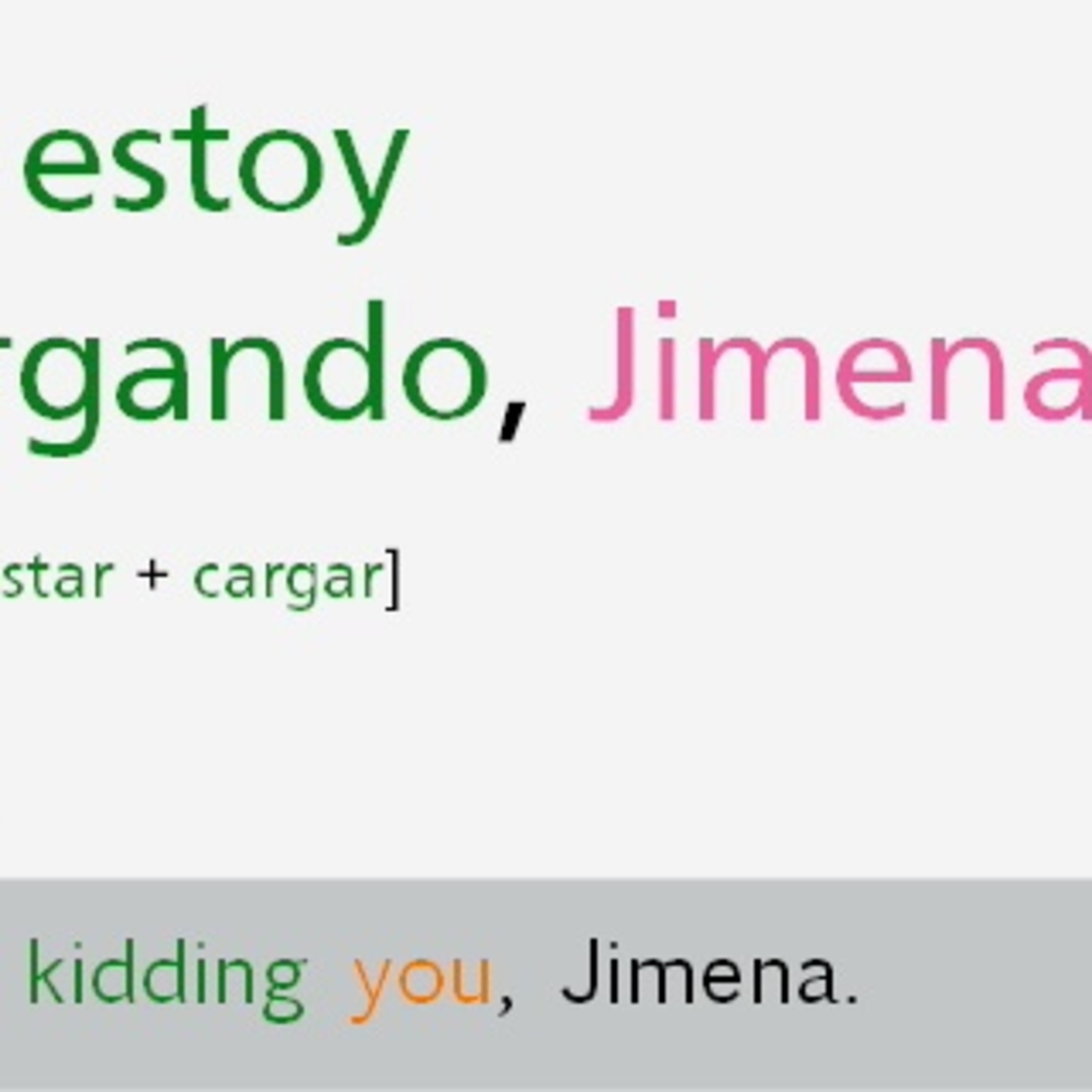 Michele Moore's PodcastSPA112: Present ProgressiveIn English, the present progressive is used to talk about actions that are in progress at a specific moment in time, they are used to emphasize the actual moment that the action is taking place.
The present progressive is formed by combining the verb "to be" with the present participle. (The present participle is simply the "-ing" form of a verb.)
Bob is talking on the phone.
Mom is washing the dishes.
We are leaving at 6am.
In Spanish, the present progressive is formed by using the verb “estar”
yo estoy
tú estás
Ud. está
él está
ella está
noso...2012-01-2710 min
Michele Moore's PodcastSPA112: Present ProgressiveIn English, the present progressive is used to talk about actions that are in progress at a specific moment in time, they are used to emphasize the actual moment that the action is taking place.
The present progressive is formed by combining the verb "to be" with the present participle. (The present participle is simply the "-ing" form of a verb.)
Bob is talking on the phone.
Mom is washing the dishes.
We are leaving at 6am.
In Spanish, the present progressive is formed by using the verb “estar”
yo estoy
tú estás
Ud. está
él está
ella está
noso...2012-01-2710 min Michele Moore's PodcastEl MenúSpanish 2
Vocabulary night class2012-01-2711 min
Michele Moore's PodcastEl MenúSpanish 2
Vocabulary night class2012-01-2711 min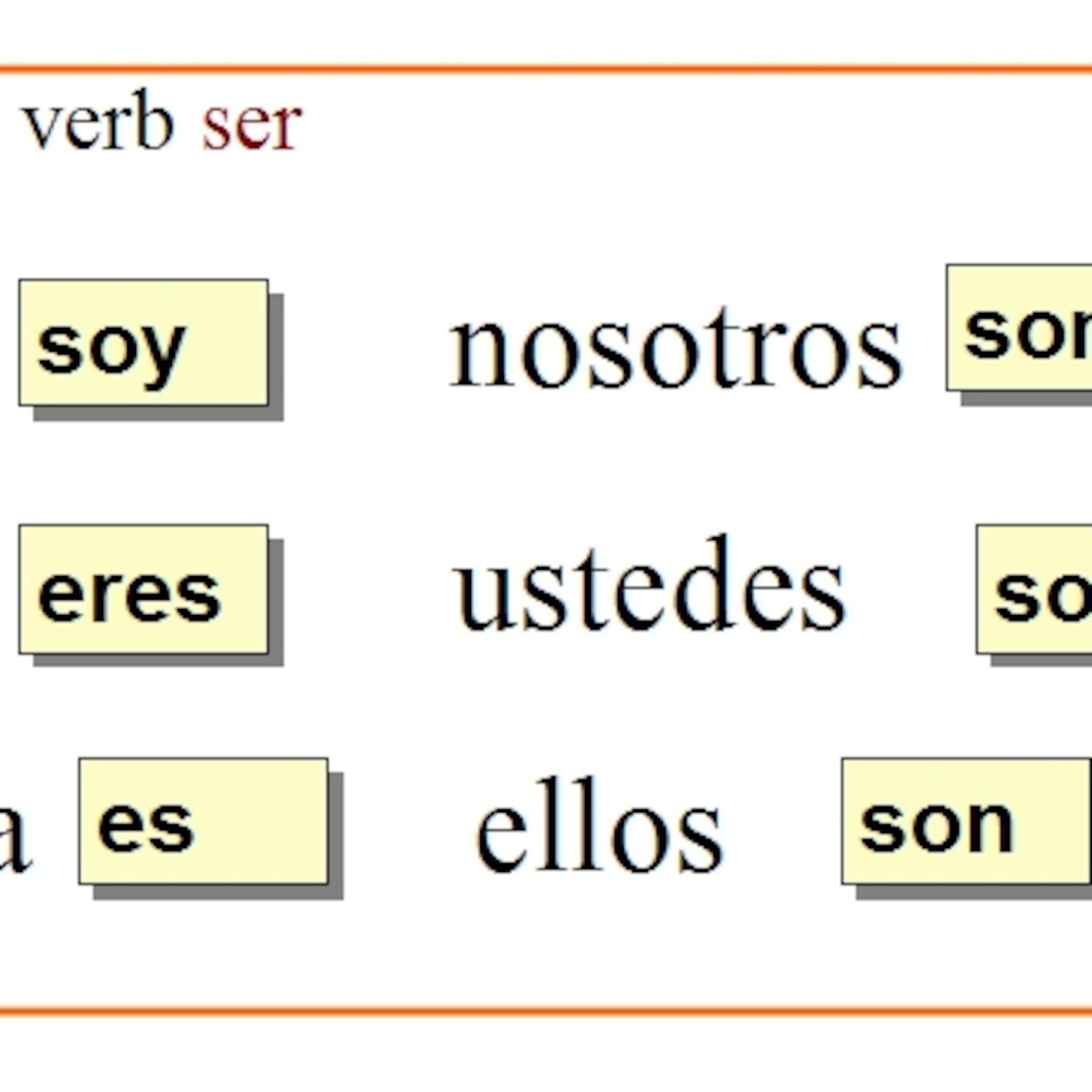 Michele Moore's PodcastSPA111: The Verb SERIn English, the verb "to be" can be conjugated in the present tense like this:
To be I am You are He is, She is, It is
We are You all are They are
We use it to talk about time, health, describe characteristics, describe personalities, tell age, and location of a specific event or place.
What time is it?
It's 3:00pm.
How are you?
He is so cute.
She is nice.
I am 40 years old.
The party is in T building.
In Spanish, there are 2 main verbs that are used to express "to be" Ser and Estar. Both...2012-01-2504 min
Michele Moore's PodcastSPA111: The Verb SERIn English, the verb "to be" can be conjugated in the present tense like this:
To be I am You are He is, She is, It is
We are You all are They are
We use it to talk about time, health, describe characteristics, describe personalities, tell age, and location of a specific event or place.
What time is it?
It's 3:00pm.
How are you?
He is so cute.
She is nice.
I am 40 years old.
The party is in T building.
In Spanish, there are 2 main verbs that are used to express "to be" Ser and Estar. Both...2012-01-2504 min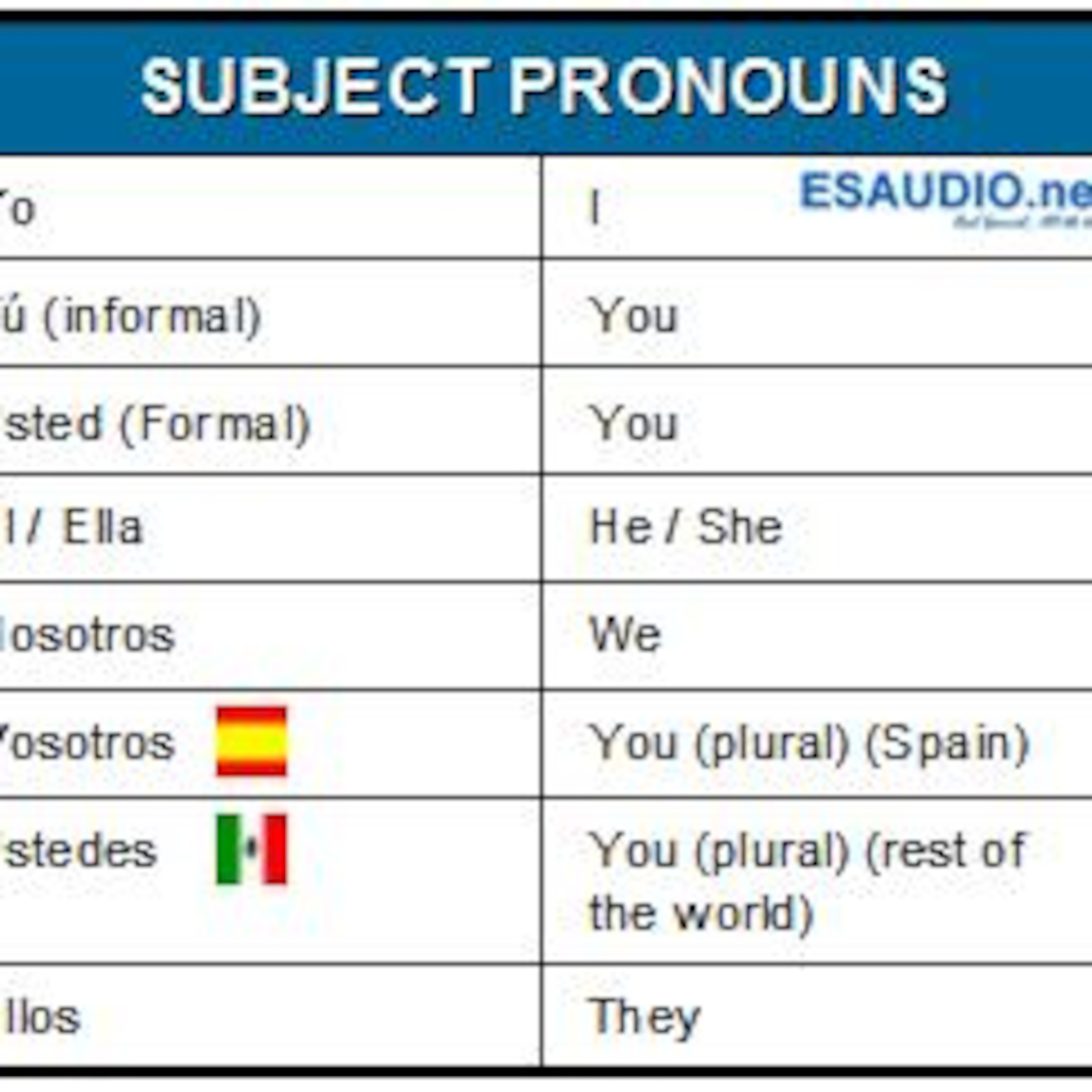 Michele Moore's PodcastSPA111: Subject PronounsSUBJECT PRONOUNS
The subject of a sentence, the noun, is the person or thing which performs the action. The Subject pronoun replaces this person or thing, the noun. Before you can fully understand how to conjugate verbs you must understand subject pronouns.
English 1st person singular I
Spanish 1st person singular yo
English 2nd person singular You
Spanish 2nd person singular *tú
English 3rd person singular He/She/it
Spanish 3rd person singular él/ella/*usted (Ud.)
English 1st person plural we
Spanish 1st person plural nosotros/nosotras
English 2nd person plural you all (y'all)
Spanish 2nd person plural *vo...2012-01-2512 min
Michele Moore's PodcastSPA111: Subject PronounsSUBJECT PRONOUNS
The subject of a sentence, the noun, is the person or thing which performs the action. The Subject pronoun replaces this person or thing, the noun. Before you can fully understand how to conjugate verbs you must understand subject pronouns.
English 1st person singular I
Spanish 1st person singular yo
English 2nd person singular You
Spanish 2nd person singular *tú
English 3rd person singular He/She/it
Spanish 3rd person singular él/ella/*usted (Ud.)
English 1st person plural we
Spanish 1st person plural nosotros/nosotras
English 2nd person plural you all (y'all)
Spanish 2nd person plural *vo...2012-01-2512 min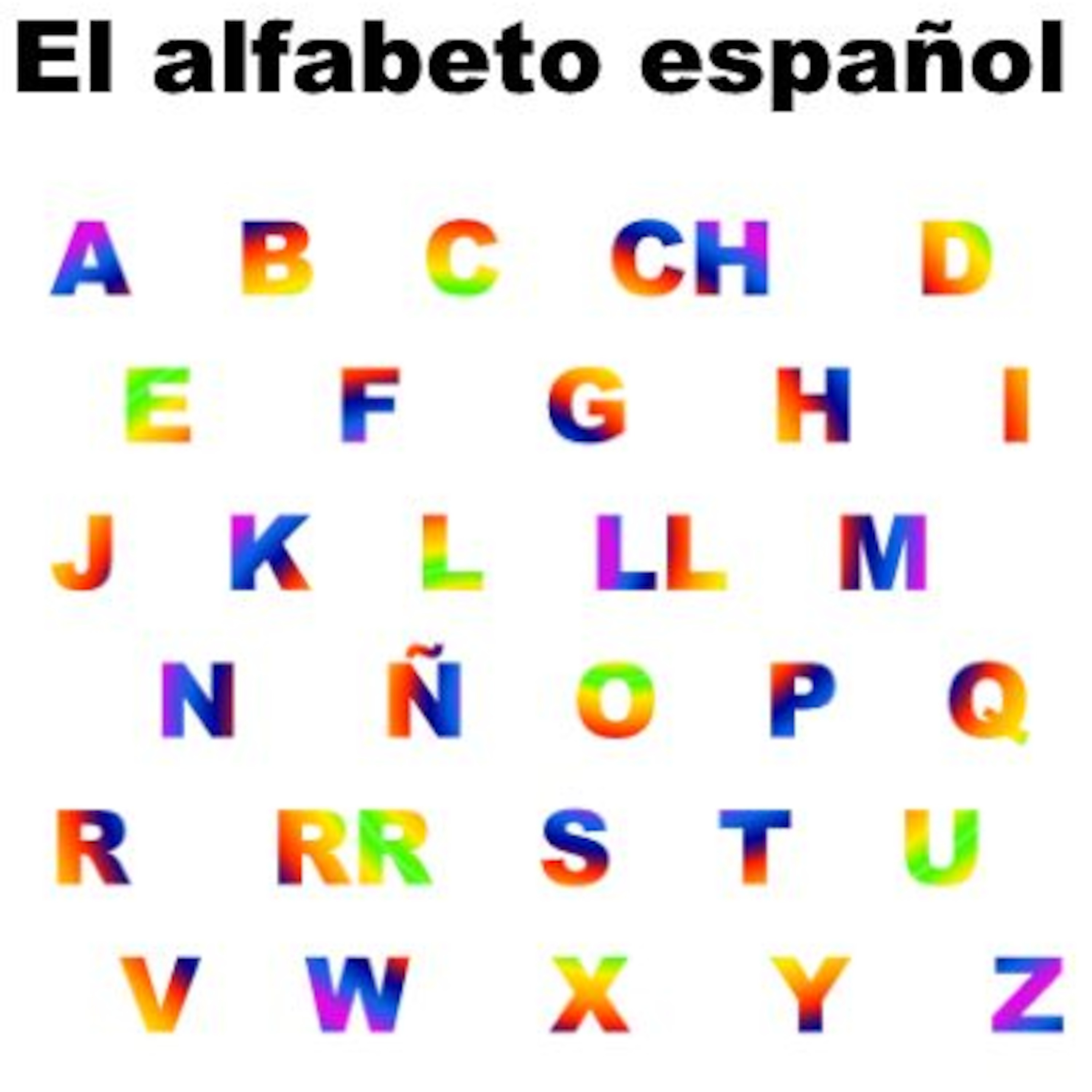 Michele Moore's PodcastEpisode 5: The ALFABETLETTER NAME PRONUNCIATION ENGLISH SPANISH WORD
A a ah Accident Accidente
B be bay Bank Banco
C ce say Cafeteria (K) Cafetería (K)
Color (K) Color (K)
Cuban (K) Cubano (K)
Cereal (S) Cereal (S)
City (S) Ciudad (S)
*CH che chay Check Cheque
D de day Disaster Desastre Day sas tray
Anda ahn da
Caldo Kal doe
(at the beginning of word or after “n” or “l” D sounds the same as in English, everywhere else it sounds like “th” in they, but softer)
Nada Na tha
Todo Toe Tho
E e ay Exercise Ejercicio (sounds like the
...2012-01-2520 min
Michele Moore's PodcastEpisode 5: The ALFABETLETTER NAME PRONUNCIATION ENGLISH SPANISH WORD
A a ah Accident Accidente
B be bay Bank Banco
C ce say Cafeteria (K) Cafetería (K)
Color (K) Color (K)
Cuban (K) Cubano (K)
Cereal (S) Cereal (S)
City (S) Ciudad (S)
*CH che chay Check Cheque
D de day Disaster Desastre Day sas tray
Anda ahn da
Caldo Kal doe
(at the beginning of word or after “n” or “l” D sounds the same as in English, everywhere else it sounds like “th” in they, but softer)
Nada Na tha
Todo Toe Tho
E e ay Exercise Ejercicio (sounds like the
...2012-01-2520 min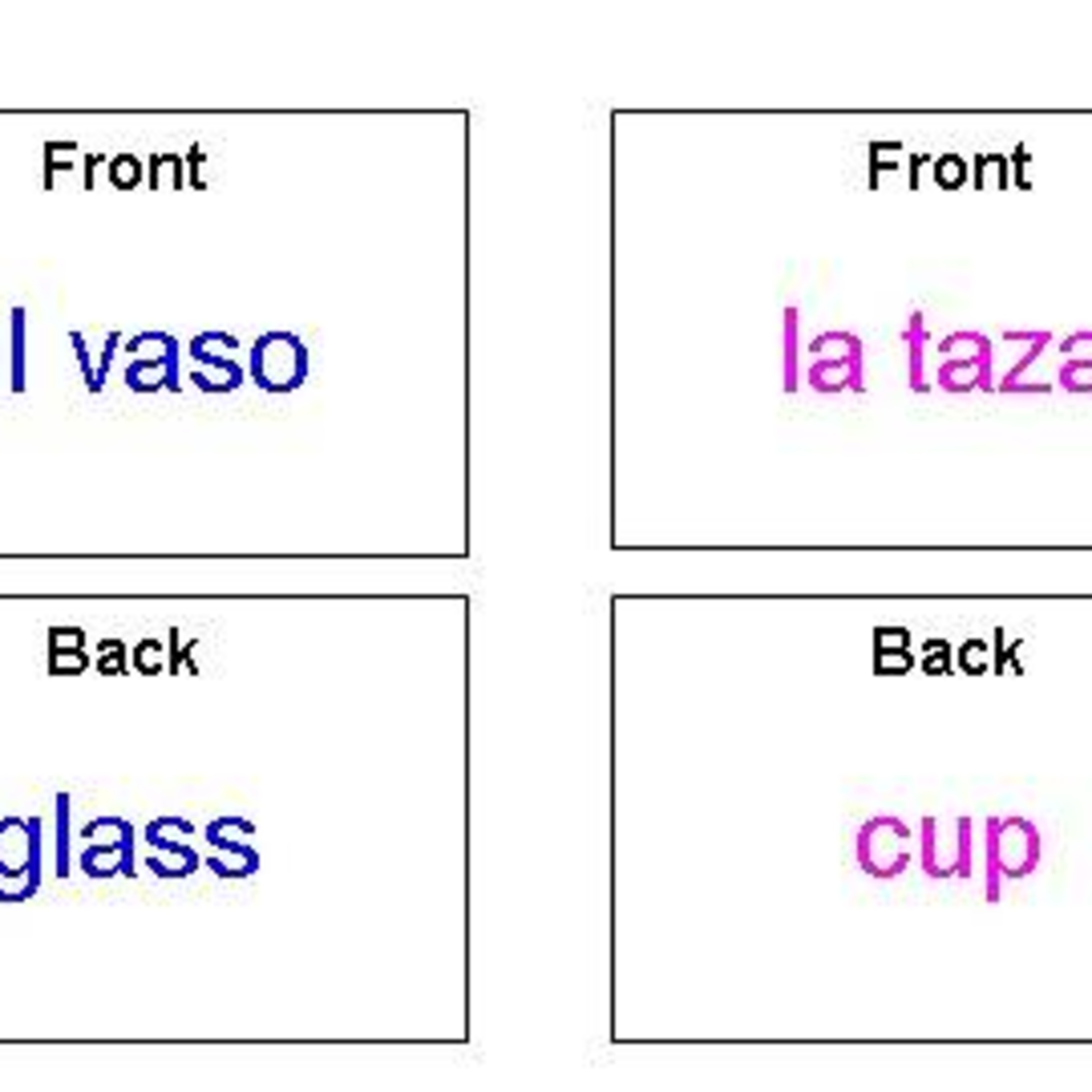 Michele Moore's PodcastSPA111: Gender and Number of NounsGender and Number Nouns
A noun is a person, place, animal, thing, or an idea.
· Proper nouns name a specific person, place, or thing (Carlos, Mexico, San Juan, and Español), is almost always capitalized
· Common nouns name everything else; things that usually are not capitalized (chico, árbol, luna, zapato).
· Count nouns name things that can be counted (cuatro sillas, dos plumas, algunas platas)
· Mass nouns name things that can't be counted (agua, aire, sangre) you can’t say they have 3 air or 4 bloods.
· Collective nouns take a singular form but are composed of more than one individual person or items...2012-01-1725 min
Michele Moore's PodcastSPA111: Gender and Number of NounsGender and Number Nouns
A noun is a person, place, animal, thing, or an idea.
· Proper nouns name a specific person, place, or thing (Carlos, Mexico, San Juan, and Español), is almost always capitalized
· Common nouns name everything else; things that usually are not capitalized (chico, árbol, luna, zapato).
· Count nouns name things that can be counted (cuatro sillas, dos plumas, algunas platas)
· Mass nouns name things that can't be counted (agua, aire, sangre) you can’t say they have 3 air or 4 bloods.
· Collective nouns take a singular form but are composed of more than one individual person or items...2012-01-1725 min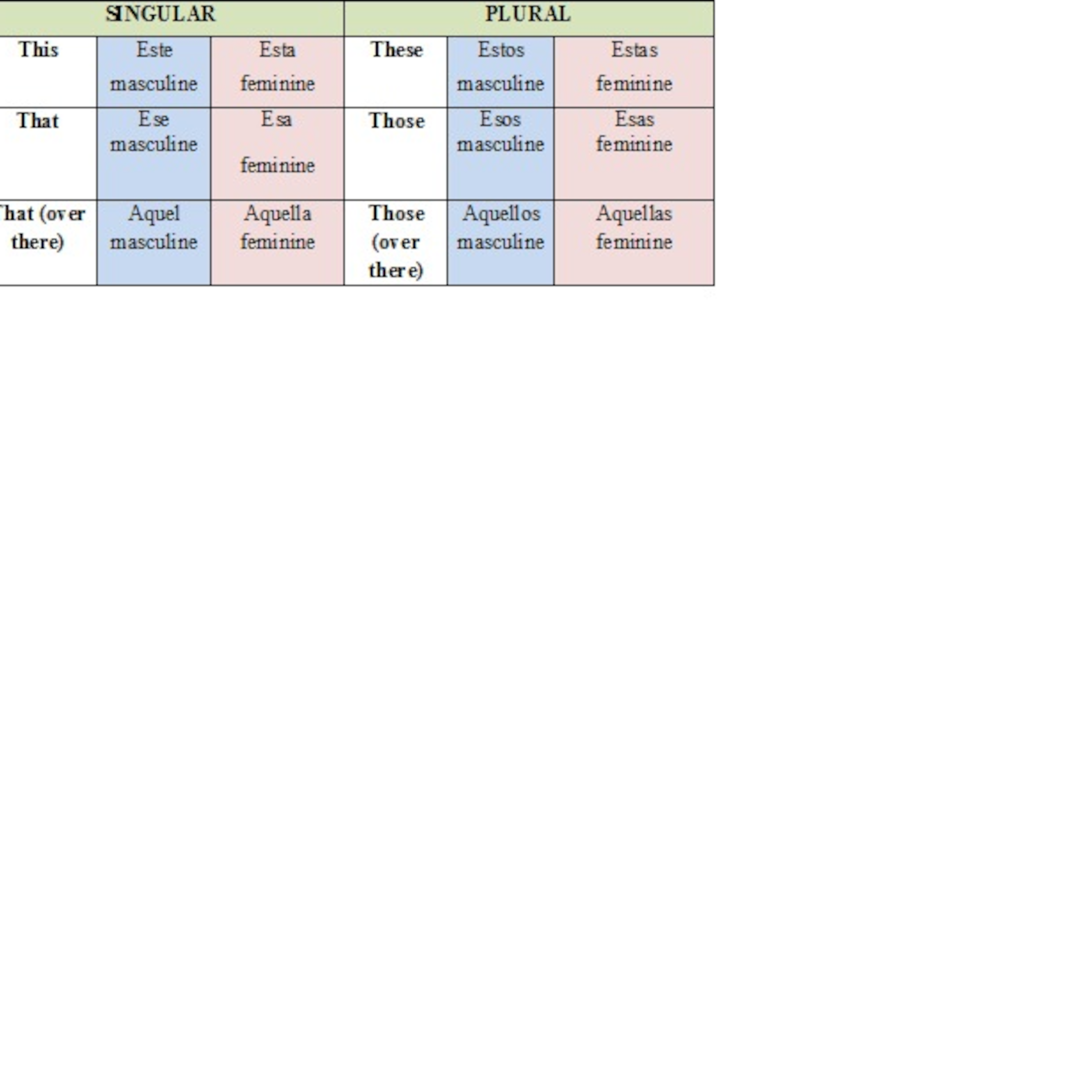 Michele Moore's PodcastEpisode 2: Demonstrative AdjectivesIn English, demonstrative adjectives (this and that) are modifiers used to indicate specific nouns in relation to ourselves.2011-10-2603 min
Michele Moore's PodcastEpisode 2: Demonstrative AdjectivesIn English, demonstrative adjectives (this and that) are modifiers used to indicate specific nouns in relation to ourselves.2011-10-2603 min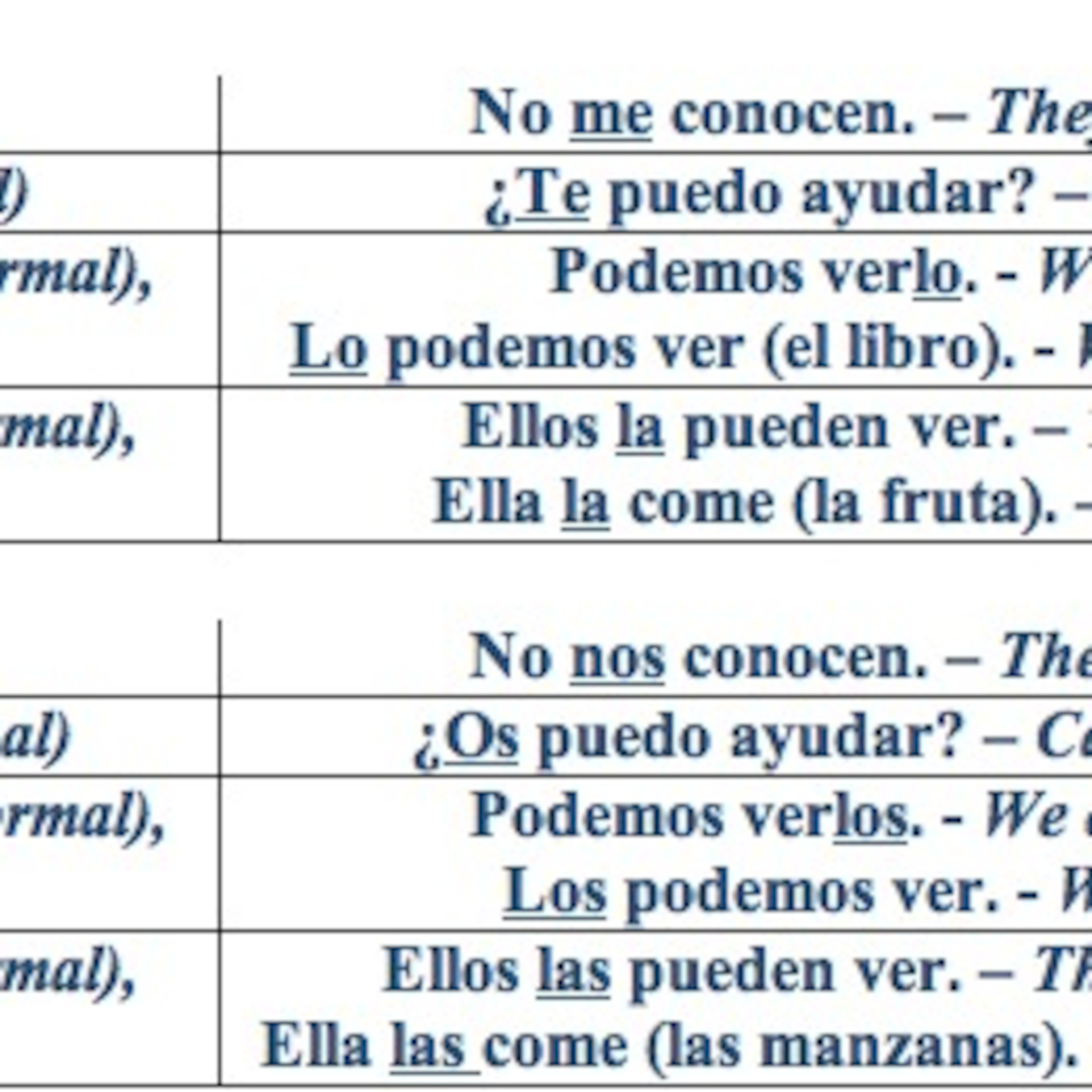 Michele Moore's PodcastEpisode 1: Direct Object PronounsSpanish 2: Direct Object Pronouns
Direct Object Pronouns2011-10-1805 min
Michele Moore's PodcastEpisode 1: Direct Object PronounsSpanish 2: Direct Object Pronouns
Direct Object Pronouns2011-10-1805 min